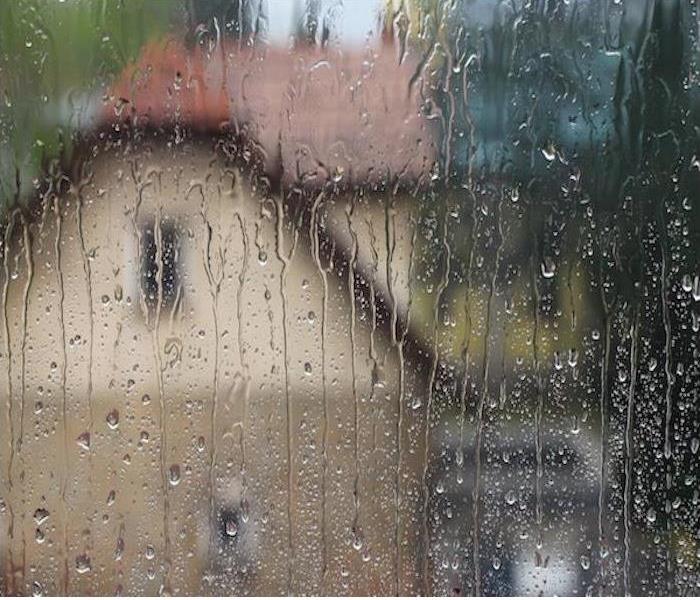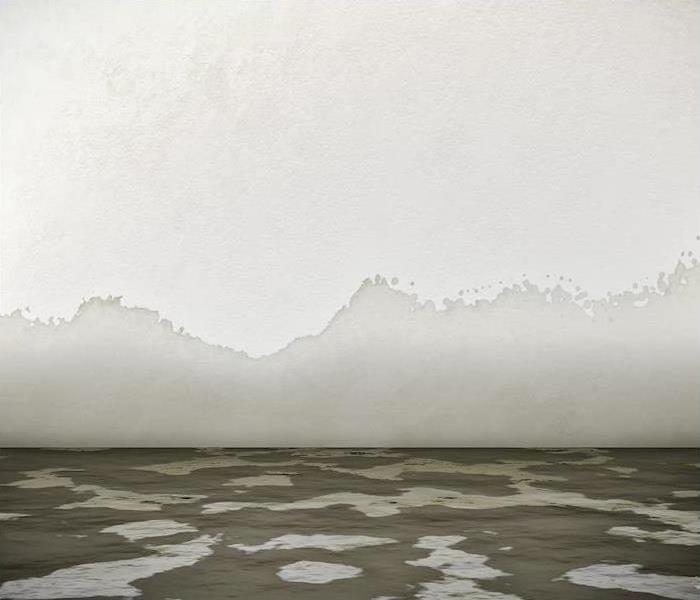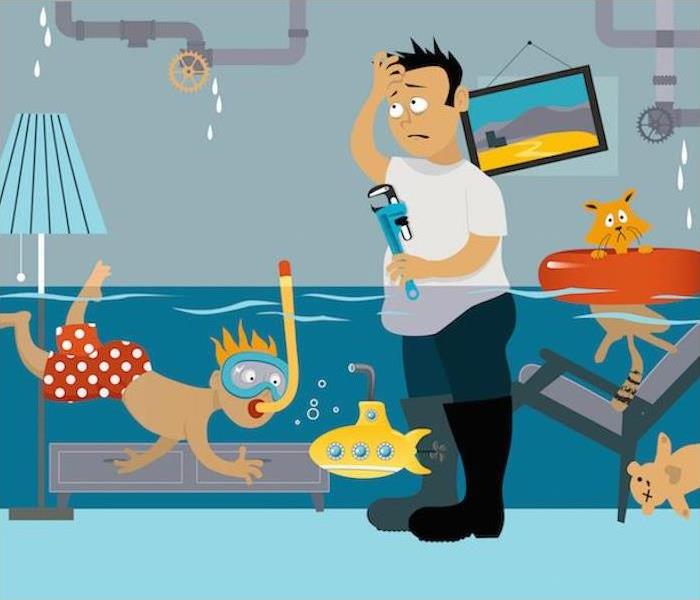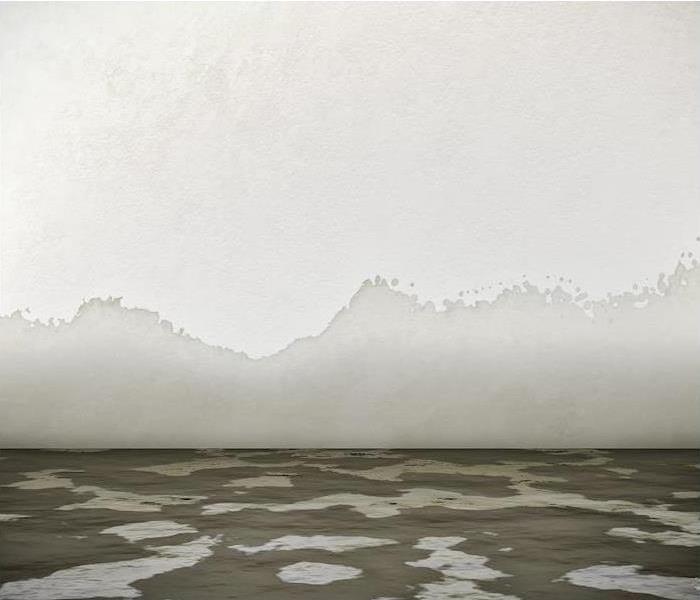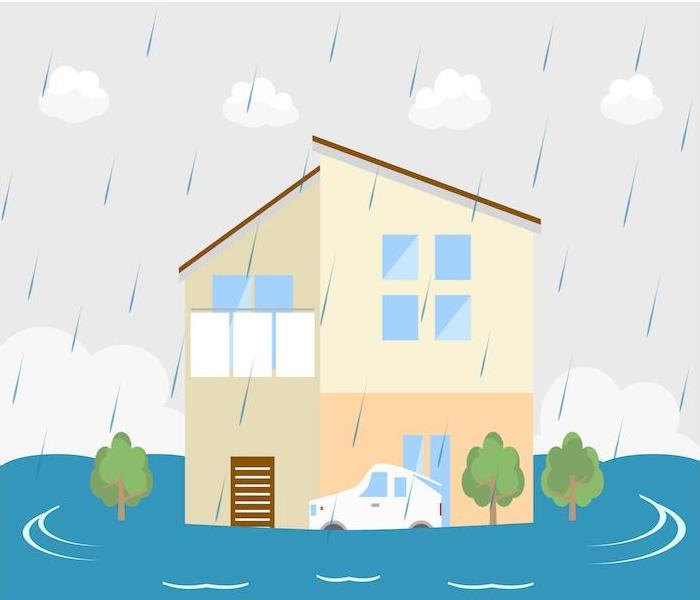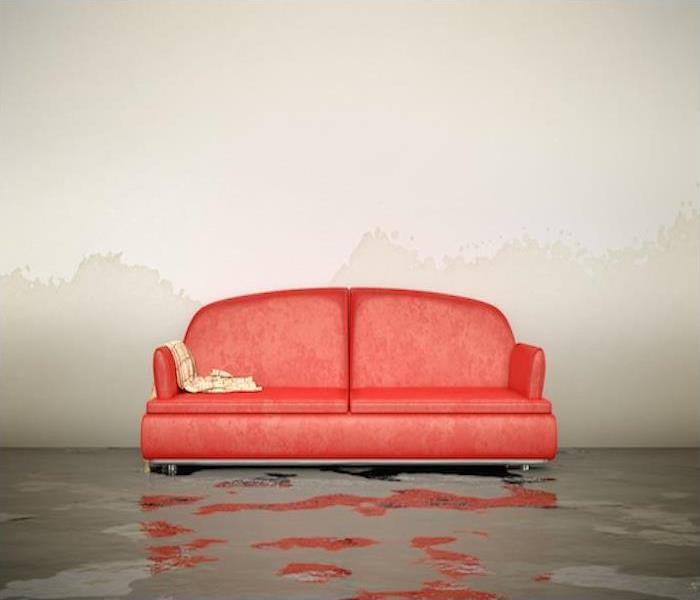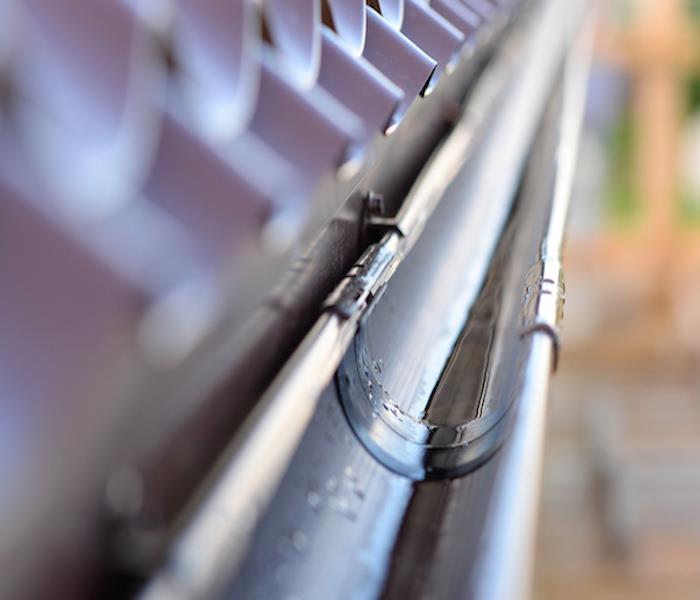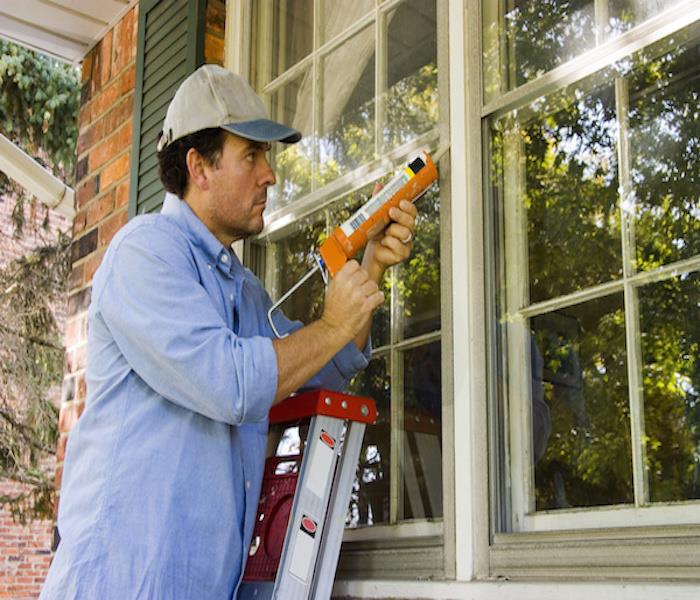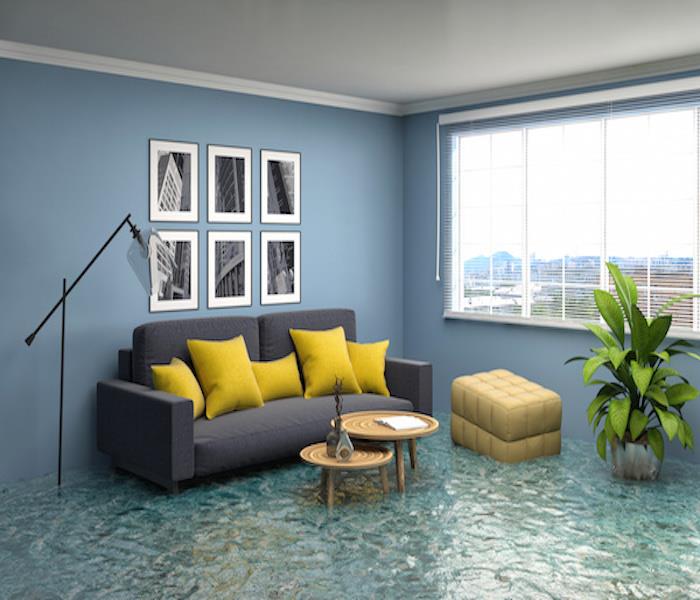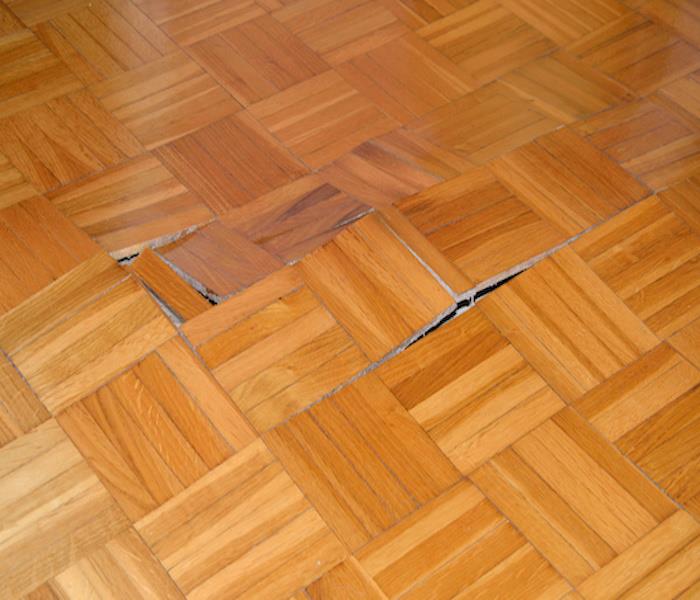Archived Water Damage Blog Posts
Holopaw Homeowner Prevents Water Intrusion During a Rainstorm?
4/2/2024 (Permalink)
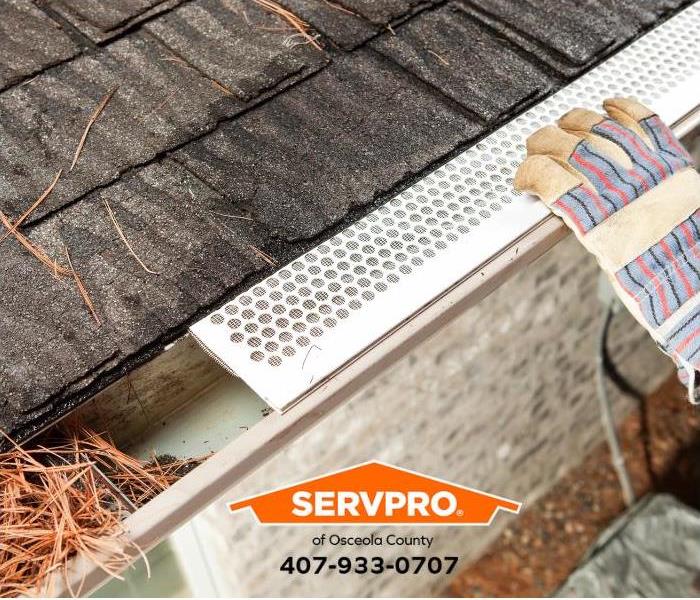 We respond to storm damage emergencies 24 hours a day in Osceola County.
We respond to storm damage emergencies 24 hours a day in Osceola County.
Our local Osceola County team restores storm damage in Holopaw every year. Residents can take preventative measures to prevent water intrusion during heavy rain events by:
Maintain gutters and downspouts: Regularly clean gutters and downspouts to ensure proper drainage. Clear any debris that could obstruct water flow and redirect water away from the foundation.
Install gutter guards: Consider installing gutter guards to prevent debris buildup and facilitate proper water flow.
Check and repair roof: Inspect the roof for missing or damaged shingles, cracks, or leaks. Repair any issues promptly to prevent water infiltration.
Seal windows and doors: Check for gaps or cracks around windows and doors and seal them with weatherstripping or caulking to prevent water seepage.
Grade the landscape: Ensure the ground slopes away from the foundation to prevent water from pooling near the house. Fill in low spots and install French drains or other drainage solutions if necessary.
Maintain landscaping: Trim trees and shrubs near the house to prevent branches from damaging the roof during storms. Consider using mulch and plants with deep root systems to absorb excess water.
Monitor indoor humidity: Use a dehumidifier to maintain indoor humidity levels between 30-60% to prevent condensation and moisture buildup.
Call Us Today!
When your home or commercial business in Holopaw has damage from heavy rain, our local Osceola County team will restore the damage “Like it never even happened.” Call us today at 407-933-0707.
SERVPRO® franchises are independently owned and operated.
Poinciana Kitchen Flooded by Broken Refrigerator Water Supply Line Overnight?
3/19/2024 (Permalink)
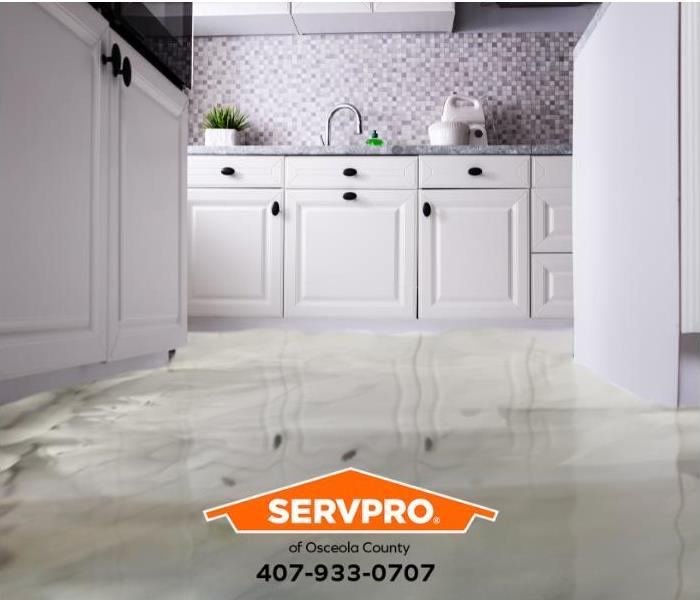 We restore water damage 24 hours a day in Osceola County.
We restore water damage 24 hours a day in Osceola County.
Our local Osceola County team has been restoring water damage in Poinciana for many years. Water supply lines to kitchen appliances are a leading cause of water damage in homes in the United States. A broken water supply line for a refrigerator can lead to a significant overnight kitchen flood due to the continuous flow of pressurized water. This supply line connects the refrigerator's water and ice dispenser to the household water source. When it breaks, water escapes freely until the issue is addressed. Overnight, the kitchen can flood for several reasons:
Water Pressure: The water supply line is usually pressurized, which means that when it breaks, a substantial volume of water can flow out quickly, leading to rapid flooding.
Unattended Appliance: Refrigerators are often left unattended overnight, allowing water to flow unchecked.
Hidden Location: The supply line is often hidden behind or beneath the refrigerator, making it difficult to notice the break immediately.
Absorbent Materials: Many kitchens have absorbent materials like flooring, drywall, or cabinets, which can quickly absorb and spread water, worsening the damage.
Continuous Leak: The refrigerator's ice maker or water dispenser may keep trying to fill, exacerbating the leak until the water supply is manually shut off.
Call Us Today!
When your home or commercial business in Poinciana has a water damage emergency, our local Osceola County team will restore the damage “Like it never even happened.” Call us today at 407-933-0707.
SERVPRO® franchises are independently owned and operated.
Cracked Water Supply Line Causes Washing Machine Washout in Reunion Home?
1/9/2024 (Permalink)
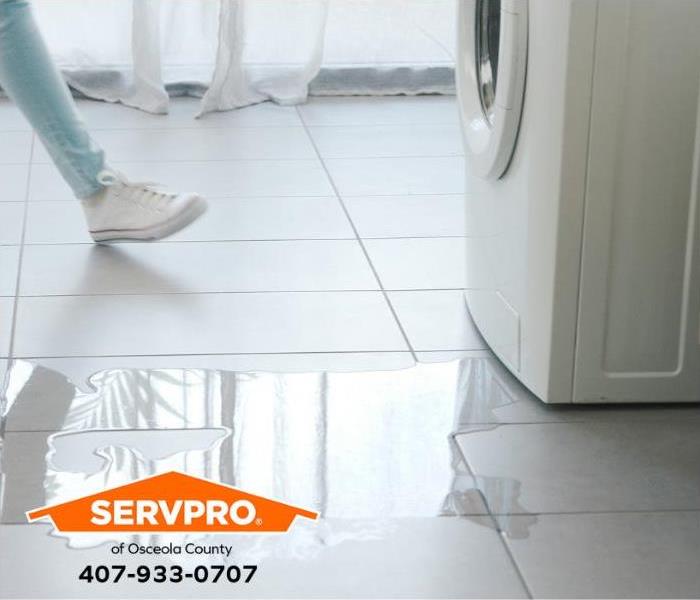 We respond to water damage emergencies 24 hours a day in Osceola County.
We respond to water damage emergencies 24 hours a day in Osceola County.
SERVPRO® of Osceola County is a leader in water damage restoration services in Reunion. Washing machines consume a substantial amount of water during operation, and any leakage from the machine can lead to water damage. Some of the most prevalent causes of washing machine leaks include:
- Faulty seals or gaskets in front-loading washing machines
- Loose connections in the supply line hoses
- Cracked or damaged supply line hoses
- Potential failure of the water pump
- Corrosion at the machine's bottom, resulting in leaks
If you're uncertain about the source of the leak, our team is here to assist you. Our technicians utilize advanced diagnostic equipment to pinpoint excess water and identify the origins of leaks. As part of the remediation process, we'll locate the source of water damage and make necessary repairs. It's worth noting that many washing machine-related water emergencies occur when the machine is running and no one is present. Consequently, never leaving your home unattended when the washing machine operates is advisable.
Why are we a top choice for water damage restoration services?
- 24-Hour Emergency Service
- Faster to Any-Sized Disaster
- Highly Trained Technicians
- A Trusted Leader in the Restoration Industry
- Locally Owned and Operated
- Advanced Restoration and Cleaning Equipment
Call Us Today!
When your home or commercial business in Reunion has a water damage emergency, our local Osceola County team will restore your water damage “Like it never even happened.” Call us today at 407-933-0707.
SERVPRO® franchises are independently owned and operated.
6 Entrances to Seal from Water Leaks
8/9/2022 (Permalink)
Even a small leak in your home can cause major water damage. For this reason, it’s important to seal all entrances where water can enter the home. These leaks can occur in several places in your home and may not even be noticeable until it’s too late. That’s why you need to be vigilant and take preventative steps to stop these leaks before they start.
While one type of material used in a house in usually very weather resistant, houses are made up of many different types of materials. Most of the leaks in homes come from where these different materials meet. Sealant fills the gaps in these materials in order to create a waterproof barrier. These are six places where you need sealant to prevent water leaks.
Window
Due to their access to the outside, windows are common causes of water leaks into a home. To prevent these potentially dangerous leaks from occurring, sealant should be applied to the entire perimeter of the window, both inside and outside. The sealant will keep the water on the outside from sneaking its way in and, if any water does gets in, it will keep it from getting all the way in where it can do damage. If the window has trim, the bottom of that trim shouldn’t be caulked as it allows the water to trickle down and outside.
Door Frame
Door frames are a common entrance point for moisture to creep into the home. Sealant should be applied around the frame and threshold everywhere that’s flush, which is to say anywhere that there are two perfectly even adjoining surfaces. Sealant should also be applied to where the door frame and the trim or siding meet. Remember that there are several different layers that make up the door frame and you want to make sure that you seal all of them so water can’t get through.
Soffits and Fascia Boards
Soffits are the underside of a roof overhang while fascia are the front boards that gutters are typically attached to. Being outside and on the roof of the house, soffits and fascia are constantly around water making their protection of the utmost importance in order to protect the home from potential water leaks and eventual damage. The application of sealant behind these boards will not only ensure that water doesn’t leak through them and into the home but will allow them to last longer.
Where Deck Attaches to the House
It doesn’t matter what type of deck you have, a roof deck or a self-supporting deck, whenever two types of materials come together, there’s a chance that water can get through. Applying sealant to these areas is key to ensuring that water doesn’t get into your house causing damage. Another spot to be aware of is where the railing attaches to the house. Again, these are two different types of materials that come together which provides opportunity for water to sneak into the home.
Cracks and Gaps Along Concrete or Masonry
Any cracks or gaps that may appear along masonry should be sealed using transparent caulk to ensure that water doesn’t enter into the house. If there are any cracks or gaps in concrete, you should use gray caulking which is specially made for use on concrete. While filling in cracks or gaps in concrete should be done regardless of where it is, special attention should be paid to where the concrete meets with other materials which is susceptible to water leaks.
Flashing
The purpose of flashing is to bridge any gaps where two materials come together like where the roof and chimney connect or where a deck connects with the house. This strip has its own seams where two different materials come together making it susceptible to potential water damage. Wherever flashing is in your house, sealant should be applied. And while you’re at it, check to see if any of the flashing needs to be replaced.
The smallest of water leaks has the potential to create major water damage in your home. Applying sealant on these six vulnerable areas on the house will help to prevent any potential leaks from occurring. If water damage does occur in your home, contact the professionals at SERVPRO to correct the situation.
Signs of Water Damage
8/5/2022 (Permalink)
It may not seem like it but even the smallest plumbing or roof leak can create major water damage to your home. It can cause damage to your furniture and other possessions, some of which will have to be thrown out.
Often by the time you realize there’s a danger of water damage, it’s too late and the damage has already occurred or is occurring. For these reasons, it’s important to stay alert for any signs of unwanted water accumulating in your house. Here are some tips to help you stay vigilant and detect if any water damage may occur in your home.
Paint
If paint on the walls is blistering, bubbling, and/or flaking, that’s one of the main tell-tale signs that there’s water somewhere you don’t want it. The same goes for loose or peeling wallpaper. In these cases, there is likely water accumulating in the wall and is possibly already eating away at the structural integrity of the home.
If you’re looking around for a new home and you notice that the current owners of the home have recently painted select parts of the house such as just the ceiling or just one wall, they could be attempting to hide signs that there’s water damage.
Kitchen or Bathroom Sink
Probably nothing gives more telling signs that you might have water damage than kitchen or bathroom sinks. If a faucet base is coming loose or the caulking is starting to deteriorate, it could be a sign that you have water damage. This is especially true if the loose faucet or deteriorating caulking is combined with a laminate countertop detaching from its base or if dampness is mysteriously found under the sink cabinet or vanity.
Floors
Floors made of wood such as hardwood, engineered wood, or laminate will show water damage by the planks buckling and sticking up higher than the surrounding planks. Another sign is that they have shifted out of place. In a tile floor, if the tiles are loose or are damp for hours after anyone has used a bathtub or shower, that can be a sign of water damage.
Doors and Windows
If doors or windows gradually become harder and harder to open or close, it could be caused by water absorption causing the wooden frames to swell.
Walls and Ceilings
If any drywall is stained, usually yellow or brown, it’s likely been caused by water damage. It might also have swollen edges and seams. Any wooden wall trim, such as baseboards or crown moldings, that start crumbling could be doing so due to water damage.
Cracked Foundation
Cracks in a house’s foundation are a serious potential result of water damage. For residents of northern states, a cracked foundation could be caused by frost heave, an upward swelling of soil caused by the presence of ice. But if it’s not during the winter or in warmer climates like Florida, a cracked foundation is typically a sign of water damage.
Odors
Sometimes it’s not what you see but what you smell that alerts you to the existence of water damage. If there’s a musty mildew odor apparent in the home, it’s not because every older home eventually gives off the scent. You should find where the odor is coming from because it’s one of the signs of water damage. Another smell that could alert you to water damage is an acrid smell like that of wet diapers.
Sometimes it’s not what you smell but the reaction of your nose that alerts you that there’s water damage in the house. If your nose is itching, dripping, and/or you’re sneezing and allergies are not the cause, it might be because you’ve got water damage.
Sounds
If it sounds like there’s running or dripping in the house and nobody is using the plumbing, that’s a sign that there’s water somewhere you don’t want it to be. In this case, you should find where the sound is coming from so you can find the location of the leak.
Bills
If you’re all of the sudden paying more for your water bill and you’re not using any more water than usual, that means that water is running somewhere in the house. If it’s not a leak from a faucet that’s easily noticeable, you need to find where the water is coming from.
Water damage is one of the worst situations a homeowner will face. It can damage the building’s structure, and can damage your possessions, sometimes irreparably. If you’ve suffered water damage, contact SERVPRO to remediate the problem.
How to Avoid Water Damage
7/18/2022 (Permalink)
A house’s foundation is what holds the building together and nothing weakens a home’s foundation more than water damage. It damages the core strength of the house potentially causing structural damage, mold, and mildew. Damp wood in the house attracts termites and carpenter ants that feast on the wood and attack the structural integrity of the building.
If you don’t take preventative measures with your home, it could end up costing thousands of dollars down the road. Here are three ways you help prevent water damage in your home.
Ensure Good Drainage
Poor drainage in your home can cause the foundation to get wet causing cracks, uneven settling, and giving water pathways to entering the house. You can improve the drainage to your home and keep water away from the foundation by routinely cleaning your gutters, directing your downspouts away from the house, sloping your yard away from the foundation, and keeping the soil from getting too dry.
When your gutters get clogged, the rain water slides down the side of the house damaging the siding and foundation. Cleaning out your gutters regularly so that they don’t get clogged will prevent this problem from occurring.
You should direct your downspouts five to 10 feet away from your house. If your downspouts are too close to the house or otherwise not placed in the proper location, water can build up and seep into the foundation causing water damage. You can attach an elbow at the bottom of the downspout to redirect the water the direction you want it to go.
Sloping your yard at least six inches over a 10-foot span away from your foundation will help to keep water from getting in next to the foundation. This will prevent potential hazards such as leaning walls, cracked masonry, and leaks. If you have crawl spaces, keeping any excess water away will ensure that it doesn’t pool underneath the floor. Allowing water to get in under the floor can cause problems like mold, rot, and insect infestation.
If your soil gets too dry, it can potentially cause water damage later on. When the soil around the house is dry for a long period of time, it shrinks. Then when a big rain comes, the soil expands putting pressure on the foundation walls. You can avoid this by running a soaker hose about six inches out from the foundation and three inches under the soil. This will keep it from contracting and expanding.
Test Your Sump Pump
You may not think about your sump pump very often but you will when a storm hits. To ensure that you don’t find issues with your sump pump when it’s too late, you should check the pump at least once a year. Ideally you would check the pump several times during heavy storm season.
You can test the pump by slowly filling your pump pit with water and watching for the float to rise turning on the pump. The float you’re looking for is similar to one you would find in a toilet tank. If the water level falls, your sump pump is alright. You can test your backup pump the same way but you’ll want to unplug the main pump first.
Fix Any Water Leaks
Any persistent water leaks can lead to the growth of mold, mildew, rot, or the introduction of termites and carpenter ants. These insects appear when there is moist wood as they like to chew on the soft wood. If you’re able to fix these leaks quickly, there may be no long-term damage.
Dark spots under the pipes inside sink cabinets, stains on the ceiling, toilets that rock, and drips are signs that you may have a leak. At least once a year, you should inspect your roof to check for any missing, loose, or damaged shingles that can cause your roof to leak water. Make sure to replace any cracked caulking and check for any leaks that may be around flashing.
Preventing water damage has the potential to save you thousands of dollars due to the damage water can cause to the foundation of your home. These measures can help you to prevent water damage from occurring in your home. However, no matter how much you try to avoid it, water damage still does occur. If you have suffered water damage in your home, call the professionals at SERVPRO to remedy the problem.
Understanding Osceola Residential Water Damage Repair - The Basics
5/31/2022 (Permalink)
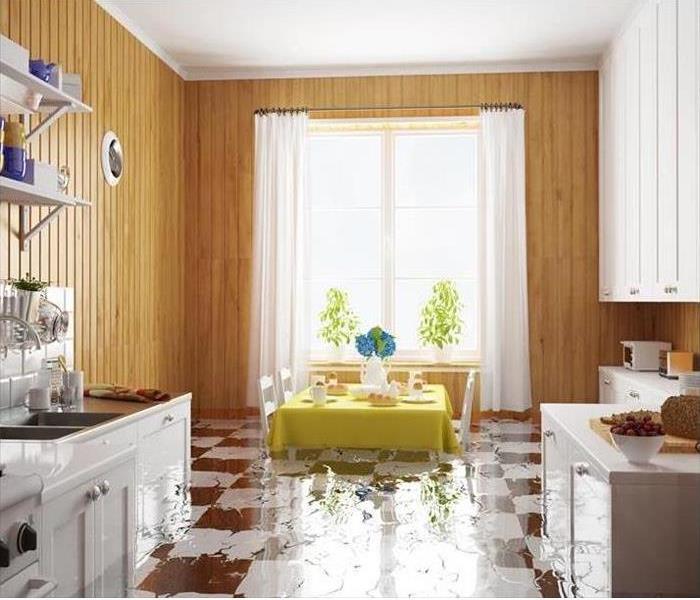 98% of basements in the U.S. will experience some type of water damage during their lifespans.
98% of basements in the U.S. will experience some type of water damage during their lifespans.
Understanding The Basics of Residential Water Damage in Osceola
Water Damage Restoration 101
Once water damage in transpires in your home or office, there's only one thing to do: call an Osceola water damage restoration company. Learn more about the helpful restoration services these individuals can offer you by reading the short outline provided below:
How Does Water Damage Repair Work?
There are several steps in the water damage repair process, and they are all designed to help get your property back in exceptional condition. Some of the steps include:
Emergency Assessment
The emergency assessment is designed to determine the extent of the damages done to your property. During the assessment, the contractors will thoroughly examine things like the structural integrity of your property to determine the best course of action. After doing so, they will develop a customized treatment plan designed to expedite and optimize each aspect of the Osceola water damage restoration process. The contractors will also remove water-damaged personal possessions from the property and take them to a warehouse where they will be photographed and cleaned.
Content Restoration
Content restoration is another component of the water damage cleanup process. Trained professionals understand that many of your personal possessions are salvageable even if they have been subjected to severe damage. For this reason, restoration experts will use advanced remediation techniques on items like photographs, books, dinnerware, china, electronics, and furniture.
Water Removal
Another component of the water damage remediation process is the removal of excess water. Technicians will use cutting edge equipment to remove water from your ceramic tiles, subfloors, ceilings, drywall, and hardwood floors. They will then utilize a thorough dehumidification and structural drying process. Some of the specialized equipment used to expedite the drying process includes thermal energy systems and desiccants. These devices combine airflow and heat to optimize evaporation.
Mold Remediation
When your residential or commercial property is subjected to water damage, a mold invasion can be the outcome. Luckily, trained technicians can utilize advanced, customized mold remediation services to remove the unwanted fungus from your property.
When you find that your home or office is impacted by water damage, there's only one company to call for excellent restoration services: SERVPRO of Osceola County. Our IICRC-certified professionals are passionate about getting your home or office back in excellent condition with lightning speed, and we also offer 24/7 emergency services to ensure that we can start working as soon as an issue surfaces.
Locally Owned Company with National Resources
As a locally owned and operated business, SERVPRO of Osceola County is strategically located to respond quickly to your flood and water emergency event. When water damage occurs in Kissimmee, Osceola, or surrounding areas, we have the resources and personnel to help. Call us today! 407-933-0707
The Process Involved In Water Damage Restoration
1/20/2022 (Permalink)
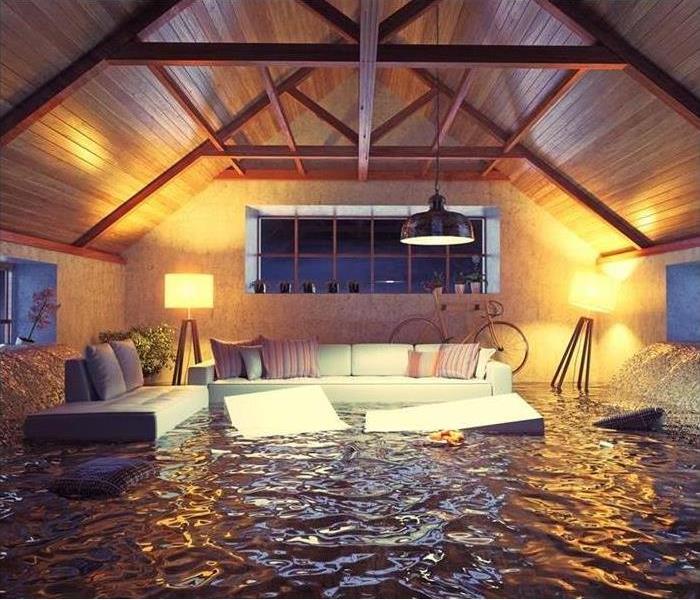 Although water damage can happen quickly and cause immense damage, there are ways to prevent a lot of it.
Although water damage can happen quickly and cause immense damage, there are ways to prevent a lot of it.
Water Damage Restoration: Processes And Procedures
Water damage is a complex household disaster that can have a devastating effect on a residential property owner's living space. In addition to precipitating mold growth, water damage can do substantive damage to the structural integrity of the homeowner's property. However, attaining high-quality water damage restoration services can preclude this property destruction from transpiring. There are several processes and procedures that restoration experts will utilize to restore the homeowner's property. Here are some of them:
Evaluating the Damage:
Once the homeowner calls a water damage restoration company, one of the first things they will do is a property evaluation. This assessment involves evaluating the property to determine the depth of damages. Contractors will document the materials that were affected by the damage and also develop an estimate for how much repairing the damages will cost. The evaluation is completed through the use of specialized tools such as water sensing equipment. This equipment enables the contractors to determine how deeply the water has penetrated household structures and materials.
Once the contractors complete the evaluation, they will move forward with the cleaning, drying, and sanitizing work. They will also deodorize the regions of the property that were affected by water damage.
The next part of the process involves treating the structure of the property with equipment like dehumidifiers, air scrubbers, wood floor drying systems, sub floor drying equipment, and air movers. Once the drying period is complete, the property structure will be assessed to determine whether any blemishes or inconsistencies exist. If so, they will be perfected.
Observation and Supervision
Completing the water damage restoration work in a thorough fashion is immensely important. To ensure that all processes are completed thoroughly, contractors will monitor the restoration procedures so that top notch results are achieved. Some of the things that may require observation and supervision include the setting up of drying equipment and ensuring that machines are working properly.
Intermediate and Completion
During the immediate stages of the restoration process, the drying and setting of the property structure is completed. After these steps are completed, a final inspection is done to ensure that the process has been finalized correctly.
Although water damage can be a challenging issue to deal with, the professionals at, SERVPRO Of Osceola County, can assist you. Our IICRC-certified technicians will provide you with the diligent, detail-oriented work that gets your residential property back in great shape. Don't delay a moment longer.
Locally Owned Company with National Resources
As a locally owned and operated business, SERVPRO of Osceola County, is strategically located. Call us today! (407) 933-0707
Avoid Water Damage Caused By Air Conditioners
12/20/2021 (Permalink)
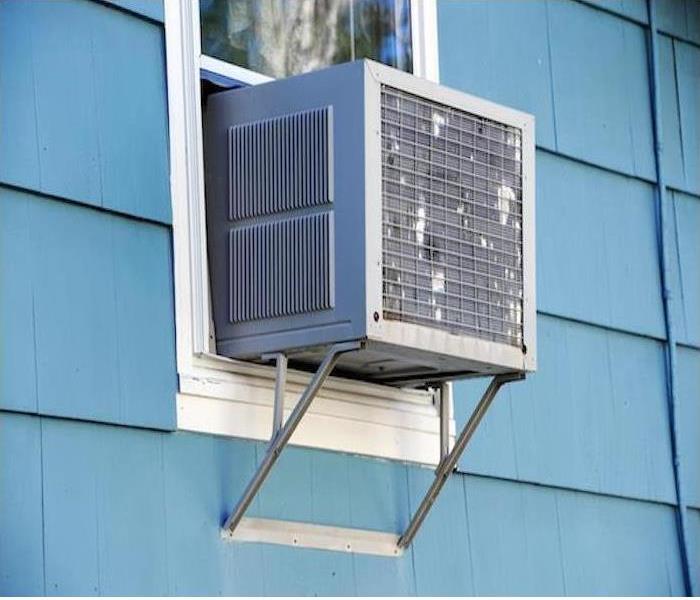 You should have your air conditioner inspected annually to prevent any damage or loss of property.
You should have your air conditioner inspected annually to prevent any damage or loss of property.
Here in sunny Florida, air conditioners are a warm weather necessity. Now that fall is here and winter is right around the corner, it is the perfect time to show your air conditioner the tender loving care it needs in order to avoid any water damage to your home.
When an air conditioner is not running properly, it can begin leaking water. Air conditioners commonly leak water when a pump is broken, the outside temperature is too cold, or there is air leakage because the seal is not tight enough. When issues with air conditioners occur, the ice within the unit melts, causing water to overflow from the pan and cause damage to ceilings, floors, and drywall.
As with every appliance, maintenance and upkeep are key when it comes to getting the most out of the product. Keeping air conditioners properly maintained can prevent any of this from happening, so that when the hot and humid summer days roll back around, cool air is easily available.
Here are some tips on how to maintain your air conditioner so that it is summer ready.
Have Your Air Conditioner Inspected
This should be an annual process done by an experienced SERVPRO of Osceola County technician. The inspections include checking the drains, the coils, and the contacts. If any repairs are needed, the technician will make sure it is serviced immediately. During an inspection, SERVPRO technicians will check the refrigerant levels, test for any leaks, check for duct leakage in the system, measure the evaporator coil airflow, inspect the electric terminals, clean and tighten any loose electric terminals, and check belts and oil motors. Lastly, technicians will check the accuracy of the thermostat indoors and ensure that it is monitoring airflow correctly.
Purchase an Algaecide Treatment
The algaecide treatment ensures that algae does not grow within the air conditioner and lead to clogged rain. It is a reasonably priced treatment and is worth it in comparison to having to purchase a new air conditioner as a result of algae growth.
Change the Air Conditioning Filter Regularly
Once a month, your air conditioning filter should be changed and replaced with a new, fresh one. Dirty filters, a well as any tall grass or shrubs too close to the air conditioner can restrict air from entering the unit. When air is restricted, the air conditioner works harder and risks the chances of further damage occurring to the unit.
Condensate the Drains
The drains are the main area that water, whether it be frozen or condensed travels in an air conditioner so make it a point to run a stiff wire through the unit’s drains annually to prevent a unit from reducing humidity. The result of a clogged drain could be moisture that can damage walls and carpet.
Invest in an Overflow Shut Off Device
This device is installed on the drain line and prevents drain back up that could possibly result in water overflowing from the air conditioner, resulting in damage. It simply shuts the air conditioner off if there are any backups in the drain. If that is the case, you will notice that your air conditioner is not running and that you should call a SERVPRO of Osceola County technician to come inspect the issue.
Prepare for Winter
Since the air conditioning will not be used in the winter months, cover any room air conditioners or remove and store them. If you have an outdoor unit, cover the air conditioner to protect it from debris. Everyone needs a break sometimes and this includes your air conditioner. If it is in good condition, give it the winter months to be off duty.
SERVPRO has a trusted staff of experienced technicians who are available 24-7 to inspect, repair, and restore any water damage caused by air conditioning leaks. If your air conditioner seems to be leaking water or is not functioning properly, it is crucial to take care of the issue as soon as possible so that it can be resolved quickly and further damage does not occur.
Understanding Osceola Residential Water Damage Repair - The Basics
12/2/2021 (Permalink)
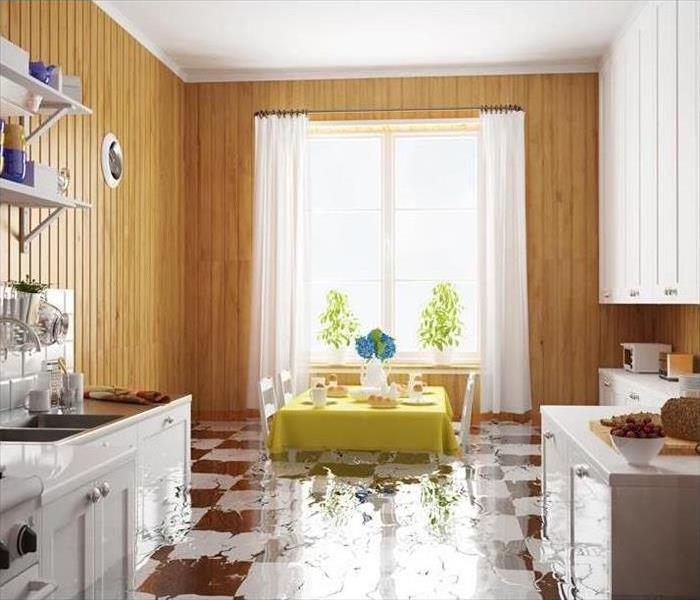 98% of basements in the U.S. will experience some type of water damage during their lifespans.
98% of basements in the U.S. will experience some type of water damage during their lifespans.
Water Damage Restoration 101
Once water damage in transpires in your home or office, there's only one thing to do: call an Osceola County water damage restoration company. Learn more about the helpful restoration services these individuals can offer you by reading the short outline provided below:
How Does Water Damage Repair Work?
There are several steps in the water damage repair process, and they are all designed to help get your property back in exceptional condition. Some of the steps include:
Emergency Assessment
The emergency assessment is designed to determine the extent of the damages done to your property. During the assessment, the contractors will thoroughly examine things like the structural integrity of your property to determine the best course of action. After doing so, they will develop a customized treatment plan designed to expedite and optimize each aspect of the Osceola County water damage restoration process. The contractors will also remove water-damaged personal possessions from the property and take them to a warehouse where they will be photographed and cleaned.
Content Restoration
Content restoration is another component of the water damage cleanup process. Trained professionals understand that many of your personal possessions are salvageable even if they have been subjected to severe damage. For this reason, restoration experts will use advanced remediation techniques on items like photographs, books, dinnerware, china, electronics, and furniture.
Water Removal
Another component of the water damage remediation process is the removal of excess water. Technicians will use cutting edge equipment to remove water from your ceramic tiles, subfloors, ceilings, drywall, and hardwood floors. They will then utilize a thorough dehumidification and structural drying process. Some of the specialized equipment used to expedite the drying process includes thermal energy systems and desiccants. These devices combine airflow and heat to optimize evaporation.
Mold Remediation
When your residential or commercial property is subjected to water damage, a mold invasion can be the outcome. Luckily, trained technicians can utilize advanced, customized mold remediation services to remove the unwanted fungus from your property.
When you find that your home or office is impacted by water damage, there's only one company to call for excellent restoration services: SERVPRO Of Osceola County. Our IICRC-certified professionals are passionate about getting your home or office back in excellent condition with lightning speed, and we also offer 24/7 emergency services to ensure that we can start working as soon as an issue surfaces.
Locally Owned Company with National Resources
As a locally owned and operated business, SERVPRO of Osceola County is strategically located to respond quickly to your flood and water emergency event. When water damage occurs in Kissimmee, Osceola, or surrounding areas, we have the resources and personnel to help. Call us today! (407) 933-0707
Signs of Water Damage
11/25/2021 (Permalink)
It may not seem like it but even the smallest plumbing or roof leak can create major water damage to your home. It can cause damage to your furniture and other possessions, some of which will have to be thrown out. Additionally, it could threaten the health of the occupants in the home and put the integrity of the structure into question. Often by the time you realize there’s a danger of water damage, it’s too late and the damage has already occurred or is occurring. For these reasons, it’s important to stay alert for any signs of unwanted water accumulating in your house. Here are some tips to help you stay vigilant and detect if any water damage may occur in your home.
Paint
If paint on the walls is blistering, bubbling, and/or flaking, that’s one of the main tell-tale signs that there’s water somewhere you don’t want it. The same goes for loose or peeling wallpaper. In these cases, there is likely water accumulating in the wall and is possibly already eating away at the structural integrity of the home.
If you’re looking around for a new home and you notice that the current owners of the home have recently painted select parts of the house such as just the ceiling or just one wall, they could be attempting to hide signs that there’s water damage.
Kitchen or Bathroom Sink
Probably nothing gives more telling signs that you might have water damage than kitchen or bathroom sinks. If a faucet base is coming loose or the caulking is starting to deteriorate, it could be a sign that you have water damage. This is especially true if the loose faucet or deteriorating caulking is combined with a laminate countertop detaching from its base or if dampness is mysteriously found under the sink cabinet or vanity.
Floors
Floors made of wood such as hardwood, engineered wood, or laminate will show water damage by the planks buckling and sticking up higher than the surrounding planks. Another sign is that they have shifted out of place. In a tile floor, if the tiles are loose or are damp for hours after anyone has used a bathtub or shower, that can be a sign of water damage.
Doors and Windows
If doors or windows gradually become harder and harder to open or close, it could be caused by water absorption causing the wooden frames to swell.
Walls and Ceilings
If any drywall is stained, usually yellow or brown, it’s likely been caused by water damage. It might also have swollen edges and seams. Any wooden wall trim, such as baseboards or crown moldings, that start crumbling could be doing so due to water damage.
Cracked Foundation
Cracks in a house’s foundation are a serious potential result of water damage. For residents of northern states, a cracked foundation could be caused by frost heave, an upward swelling of soil caused by the presence of ice. But if it’s not during the winter or in warmer climates like Florida, a cracked foundation is typically a sign of water damage.
Odors
Sometimes it’s not what you see but what you smell that alerts you to the existence of water damage. If there’s a musty mildew odor apparent in the home, it’s not because every older home eventually gives off the scent. You should find where the odor is coming from because it’s one of the signs of water damage. Another smell that could alert you to water damage is an acrid smell like that of wet diapers.
Sometimes it’s not what you smell but the reaction of your nose that alerts you that there’s water damage in the house. If your nose is itching, dripping, and/or you’re sneezing and allergies are not the cause, it might be because you’ve got water damage.
Sounds
If it sounds like there’s running or dripping in the house and nobody is using the plumbing, that’s a sign that there’s water somewhere you don’t want it to be. In this case, you should find where the sound is coming from so you can find the location of the leak.
Bills
If you’re all of the sudden paying more for your water bill and you’re not using any more water than usual, that means that water is running somewhere in the house. If it’s not a leak from a faucet that’s easily noticeable, you need to find where the water is coming from.
Water damage is one of the worst situations a homeowner will face. It has the ability to cause health problems, can damage the building’s structure, and can damage your possessions, sometimes irreparably. If you’ve suffered water damage, contact SERVPRO of Osceola County to remediate the problem.
Four Basic Steps for Replacing a Leaky Toilet
6/21/2021 (Permalink)
Replacing a Leaky Toilet
Your toilet was built to last a long time, but it cannot last forever. Over time, the fixture may begin to work less efficiently and can break or develop cracks. If you have decided that it is time to replace the leaking toilet in your Kissimmee, FL home, here are some basic steps to help you get the job done.
1. Disconnect the Supply Line
Before you begin any work on the toilet, you need to make sure that it is no longer connected to the water supply line. Drain as much water from the toilet as you can and dry the rest with a sponge or towel. This will prevent any messes during the removal.
2. Remove the Old Toilet
Once the leaking toilet has been dried, you can begin the process of removing it. You should unscrew any bolts that are securing it to the floor and then move the fixture back and forth gently to break the wax seal before moving the commode to another area.
3. Prepare the Area
After the old toilet has been removed, you will need to clean up the area before you can install the new one. You should scrape off any wax that remains on the gasket and check that nothing has been damaged during the process. If everything looks fine, then you can proceed to the next step.
4. Install the Toilet
If the leaking toilet has been removed successfully and there are no damages to the area that need to be repaired, you can begin the installation. Make sure that the toilet is placed correctly and is parallel to the wall behind it before securely tightening the bolts. Depending on your building code, you may need to seal the base with caulk.
If you don’t feel confident replacing your toilet on your own, or if there is already damage in your bathroom, a water damage repair service might be able to help. They can make any necessary repairs and ensure that everything is installed correctly to prevent the need for future toilet overhauls.
Bathroom Supply Lines
6/13/2021 (Permalink)
When is It the Time to Replace a Supply Line in Your Bathroom?
Many of your household appliances that use water require a supply line. Because they are so commonly used, supply line damage can cause some major issues. It is important to call a professional as soon as you notice an issue. This can help prevent water build up in your home in Celebration, FL. Changing these lines when needed may actually help you avoid problems later on. How do you know when it's time to replace it though?
Check the Warranty
You may find that many of these hoses come with a warranty. It really just depends on what type you have. Most plastic lines come with a 5-8 year warranty. This means that you are responsible for replacing it if anything happens to it after that time is up. Steel braided ones often have a lifetime guarantee. While they are generally more expensive than the plastic ones, the benefits may be worth the extra cost. Always ask the seller about the warranty before you decide to purchase.
Watch for Damage
Supply line damage may lead to some pretty serious problems, such as standing water or mold growth. This is why it is a good idea to have a professional come out if you notice a supply line leak. Always shut off the water if you see an issue. This could be anything from a small bathroom leak to pretty serious flooding. Turning off the water can help prevent further damage from happening in your home.
If you are still unsure whether you have supply line damage, it is best to call a professional restoration company to come take a look. They may be able to help you resolve a number of issues that arise in this type of situation, such as fixing the leak and cleaning up the water. If your line gets replaced, always ask what type of warranty you are getting so that you will be aware if any future problems occur.
Does a flood mean new carpet?
3/22/2021 (Permalink)
Can my carpet be saved after water damage?
When you have a pipe break and an unexpected flood in your home, one of the biggest concerns is the damage to your floors, walls, and possessions. It behooves you to save as much as you can. It's not just economically sound, but environmentally smart, too. When your carpet gets soaked, can it be saved? The good news is that it often can be cleaned and kept. Consider the following factors:
What is the source of the flooding water?
If the water is non-contaminated or is grey water, the rug can be cleaned and used again.
- Grey water includes water from washing machines, dishwashers, bathtub or shower overflow, and toilet water with urine only.
How long has the flooring been wet?
Clean water becomes grey water after 24-48 hours, and grey water becomes black water after 24-48 hours. Black water is a source of fungus, bacteria, and other pathogens. Flooring saturated with black water must be replaced.
Does the water have minimal contaminants?
Water from a pipe break, hot water heater failure, or overflow from bathroom, kitchen, and utility sinks is considered clean water. Carpets soaked with this type of water can be cleaned and dried. The pads can also undergo a full restoration.
In instances where the water is grey, approaching black, it is advisable to clean the rug but replace the pad.
Be Aware of These Contaminants
There are some contaminants that are too toxic to mess around with. If your flooring is exposed to the following, you will need a full replacement:
- Water from sewage or storm drain backup
- Water with fecal matter, vomit, or other biological contaminants
- Water with heavy metals or chemicals
If you have a pipe break with significant flooding, let the professionals in Saint Cloud, FL asses your flooring damage. A restoration and cleanup crew will make your home look "Like it never even happened."
Water Damage and Homeowners Insurance
2/26/2021 (Permalink)
Does Homeowners Insurance Cover Water Damage?
Homeowners insurance is useful in times of an emergency. Insurance allows you to avoid having to pay out-of-pocket for expenses that are related to damage to your home. Submitting a claim after your home is damaged by water helps you recover money spent on repairs. However, it is important to know that there are positive and negative points to filing a water damage insurance claim has its good points and bad points.
Water Damage Coverage
Your insurance company covers certain types of water damage. In most instances, the insurance company will cover any damage that is the result of a sudden event. For example, if the broken dishwasher leaks water and causes any water damage, you are covered by your policy. But, any damage that results from a dishwasher that malfunctions because of inadequate maintenance or neglect will not get covered.
No Coverage
An issue that homeowners face that is not covered by a regular homeowner’s insurance policy is flood damage. If a local river overflows and floods your home, the flooding is not covered by your homeowner’s insurance policy. You will need to purchase a separate insurance policy to cover flooding. This type of insurance is advised for anyone living in an area prone to flooding.
Water damage is covered through homeowner’s insurance
Unfortunately, there are some limitations to this coverage. An accident that occurs suddenly will likely get covered. However, flood damage that arises from poor maintenance may not covered by your policy. It is important to know that you may find yourself disagreeing with your insurance company about the nature of your water damage. An incident that you believe is the result of a sudden accident may not get viewed as such by your insurer. Your insurance company may argue that the damage was caused by improper maintenance of your home.
If you need help with flood damage in Saint Cloud, FL call our teams of professionals at (407) 933-0707
#waterdamage #homeownerinsuranceandwaterdamage #Kissimmee #SERVPROofOsceolaCounty
House Flooding
11/3/2020 (Permalink)
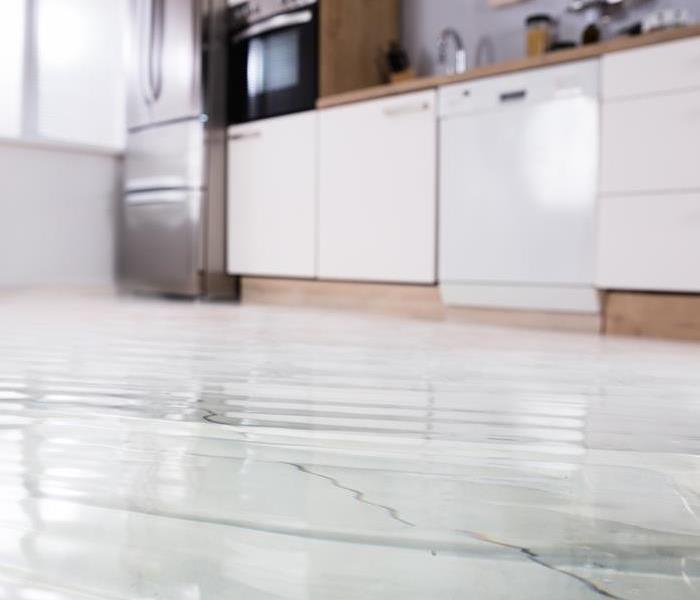 Flooded kitchen floor due to broken pipe.
Flooded kitchen floor due to broken pipe.
Water flooding in your house, business, or place of work can happen at any time. Most of the reasons for flooding are due to pipes breaking, backed up septic tanks, water heaters. When those times happen we dry up the areas and think everything is dry and fine. But what most people do not realize is that moisture can be hidden behind walls, cabinets, and rugs.
Here are some facts:
- Mildew (mold in early stage) and molds grow on wood products, ceiling tiles, cardboard, wallpaper, carpets, drywall, fabric, plants, foods, insulation, decaying leaves, and other organic materials.
- Mold growths, or colonies, can start to grow on a damp surface within 24 to 48 hours.
- It is not always visible right after it happens, meaning if you do not get a rapid response on the matter it will grow.
- Even if you dry the area it can be wet behind walls.
- Bleach does not stop the growth behind the walls.
What To Do After Flooding
- Turn off electric to the affected area.
- Call SERVPRO of Osceola County!
- Remove excess water by mopping and blotting.
- Wipe excess water from wood furniture after the removal of lamps and tabletop items.
- Remove and prop wet upholstery and cushions.
- Place aluminum foil or wood blocks between furniture legs and wet carpeting.
- Open exterior doors and windows.
- Remove colored rugs from wet carpeting.
- Remove art objects to a safe, dry place.
- Gather loose items from floors.
What NOT To Do After Flooding
- Don't leave wet fabrics in place. Hang furs and leather goods.
- Don't leave books, magazines, or other colored items on wet carpet or floors.
- Don't use your household vacuum to remove water.
- Don't use television or other household appliances.
- Don't turn on ceiling fixtures if the ceiling is wet, and keep out of rooms where ceilings are sagging.
#waterfloodinginhouse #waterdamage #SERVPROofOsceolaCounty
Flooding and Why Time is important.
10/12/2020 (Permalink)
 floods happen
floods happen
Many of us have experienced a leaky pipe, storm damage, backed up toilet, overflowed tub, and even septic back up. When a flood happened we rush to dry up the floor and clean the area. But what most do know is the moisture can cause mold to start growing. Did you know that mildew and mold will develop within 24-48 hours of water exposure?
Here are some important tips when floods happen.
- Take photos of the flooded area from the outside area
- Shut off electric to the area flooded ( do not enter a flooded room with electric on )
- Try to dry most of it if possible
- CALL our offices at 407-933-0707
SERVPRO of Osceola County will make it feel
"Like it never even happened."
How To Stop a Bath or Shower Leak
6/23/2020 (Permalink)
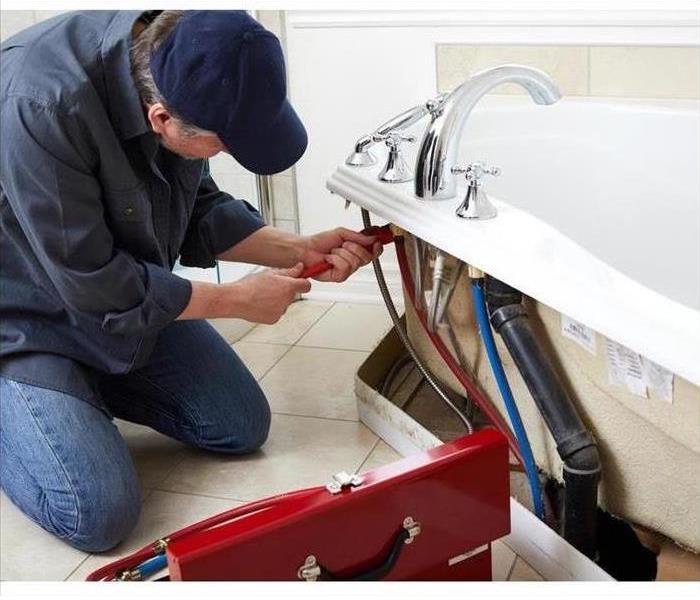 Consult a plumber to stop the leak in your bathtub
Consult a plumber to stop the leak in your bathtub
How to Identify and Fix a Shower or Bathtub Leak
A leak can result in standing water around a shower or bathtub that can leave signs of discoloration. Water damage may be apparent on the same floor, on the ceiling of the one below it or in a basement or crawlspace. Here are several pointers for identifying and fixing a shower or bathtub leak.
Replace the Shower Pan
Shower pans play a critical role in preventing leaks. If this component has worn out, you are likely to see signs of water damage. You can make sure the problem is a shower pan leak by taking the following steps:
- Fill the bath with 1.5 inches of water
- Have someone stand and walk around in the tub or shower
- Keep checking over several days
A bathtub leak caused by a shower pan may be more extensive than a drain problem or poor sealing. Expect to replace this piece every 30 years.
Repair the Drain
A faulty drain flange or gasket can also result in moisture damage. Pour water from a bucket or hose down the drain while someone monitors the area underneath. If leaking is spotted, you may have located the source.
Reseal Caulking or Grout
Caulk creates a waterproof barrier between tile and other fixtures or surface materials. If you notice standing water on the bathroom floor, re-caulking may be needed. Grout prevents moisture from getting in between tiles or behind walls where hidden mold can form.
Clean and Maintain the Shower
A shower head could also be the source of a leak. Make sure that the escutcheon is sealed with caulk or putty. It may also be necessary to replace faulty components, such as cartridges, gaskets, stems and washers.
Depending on the cause of a shower or bathtub leak, any of these measures could resolve the problem. If you cannot find a way to stop a leak, consult a plumber or a water damage restoration service in Reunion, FL.
3 Ways a Leaky Pipe Can Cost You Money
6/9/2020 (Permalink)
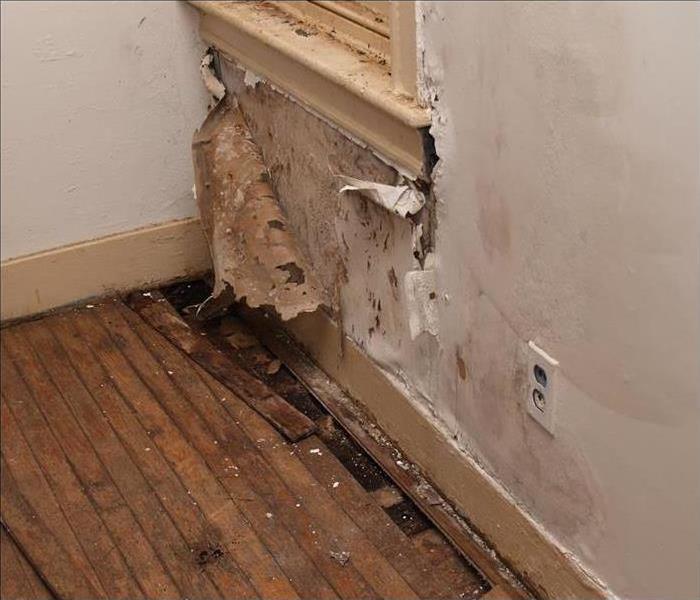 Moisture build up and caused damage to the walls.
Moisture build up and caused damage to the walls.
Three Ways a Damaged Pipe Can Cause You Money
If you have a water leak in your Osceola building, you might be tempted to push it to the back of your mind. You have more important matters to deal with, after all, right? Well, it turns out that a small leak can become a big problem if you don’t have it fixed right away. Here are just three ways that a damaged pipe could cost you a lot of money.
- Restoration and Repairs
Over time, even a small water leak can contribute to damage to your building. The moisture can build up and cause warping in walls and flooring, weakening the structure in that area. If it is unable to dry, you can end up with a mold growth that can cause discoloration and an unpleasant musty odor. Eventually, you will need to hire a water damage restoration specialist to repair the damage.
- Increased Water Bills
Depending on the location of the leak, a high water bill might be the first sign of water damage that you notice. While it might seem that only a small amount of water is lost, even tiny drips add up throughout the day. If the leak continues over a long period of time, you could be wasting hundreds, or even thousands, of dollars each month.
- Loss of Business
Sometimes, a leak is indicative of a larger problem. If your pipes are old or damaged, then ignoring a leak could potentially end in a pipe break. This will cause a much larger amount of damage to your building and can even prevent you from doing business while the repairs are being done, costing you valuable profits.
Because a water leak seems like a small problem, it is often overlooked or ignored, but this can end up costing your business big time. You should be sure to perform regular maintenance to keep everything in your building working properly. Fixing a leak early on will save you both time and money in the long run.
#leakingpipe #waterdamage #floodedwall #waterdamagecleanup #SERVPROofosceola
How To Prevent Water Damage in Your Home Before It Starts
3/23/2020 (Permalink)
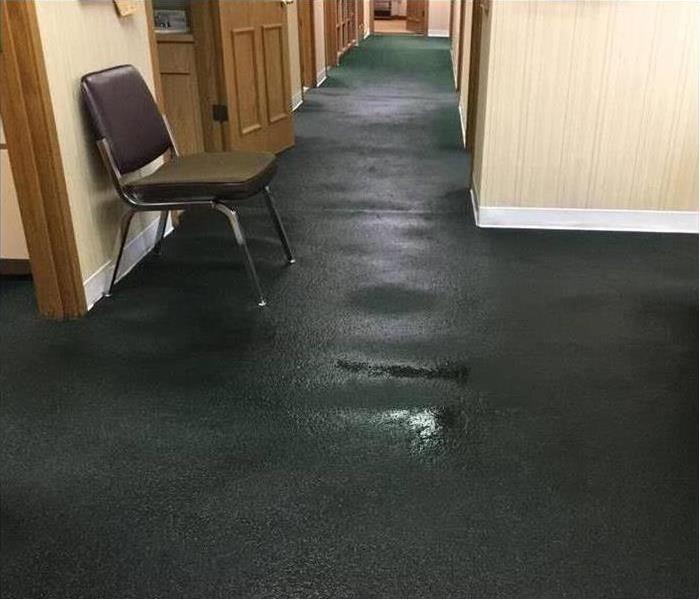 Call a professional for major water issues.
Call a professional for major water issues.
How to Prevent Water Damage in Your Home
Water in a home can be a nightmare for any residential property owner. Fortunately, there are several ways you can prevent water damage before it even starts and avoid a lengthy and expensive restoration process. By adding a few steps to your home maintenance routine, you can make sure your property in Lokosee, FL, stays dry and comfortable.
- Keep an eye on your HVAC unit. A leaking indoor heating or air conditioning unit is a ticking time bomb when it comes to flood damage. Even a small amount of water escaping from a broken pipe or connective hose is a sign that immediate repairs are needed before the unit breaks down and potentially causes a major water event. Check your HVAC system weekly for any dripping, blockage, or excess condensation, and have it serviced regularly to keep it functioning properly.
- Use your appliances with caution. Dishwashers, washing machines, and refrigerators can all unleash water in a home if they’re not evaluated and maintained on a consistent basis. Make a habit of checking for kinks or cracks in all appliance water supply lines, and only run your dishwasher and washing machine when your home is occupied. You can also consider investing in a water leakage alarm system that will alert you at the first sign of a flood.
- Call a professional for major water issues. Attempting a pipe cleanup or mold remediation when you’re inexperienced will only lead to more damage if the worst happens and your home floods. That’s why it’s important to have the name and number of a reputable water damage restoration specialist on hand to quickly assess and repair the effects of a water event in your home and minimize any lasting impact.
Any property owner will list water in a home as one of their biggest concerns. By implementing a few preventative measures into your daily routine, you can stop water damage before it starts and keep your home dry.
3 Useful Tips for Flushing Your Water Heater
2/24/2020 (Permalink)
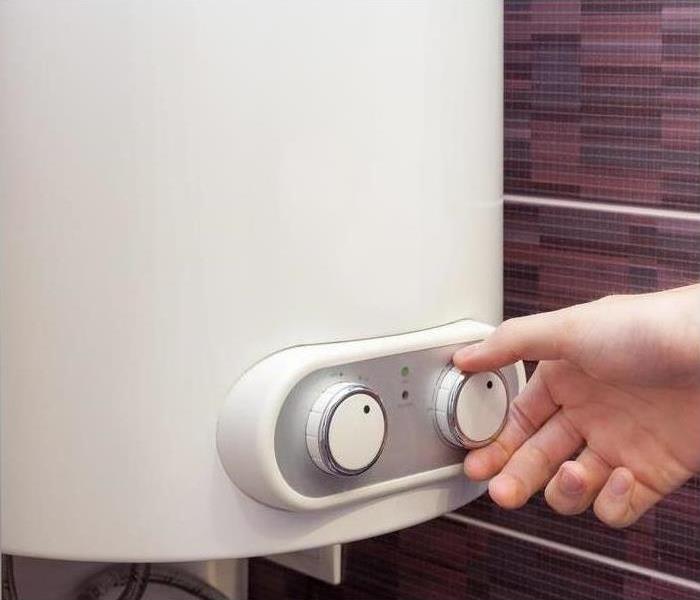 Maintenance of a water heater in Kissimmee, FL.
Maintenance of a water heater in Kissimmee, FL.
Flushing Your Water Heater
Keeping up with the maintenance of your Kissimmee, FL, residence can seem like a nuisance. However, there are some quick and painless chores you should do around the house to prevent far more expensive repairs down the road. One of these chores is completing a water heater, which only requires a small number of tools and an even smaller amount of your time. Here are three useful steps to help you commit to flushing your heater, saving yourself stress and costly expenses in the future.
- Shut off your heater and set up a necessary drainage area.
To start, it’s important that you begin by shutting off your heater, whether through extinguishing the pilot light on your gas heater or flipping the line on your circuit breaker for an electric heater. Following this, you should then connect a garden hose to your heater’s drain valve and direct the loose end towards an area that won’t be affected by any sediment buildup or warm water that’s about to be flushed out.
- Drain your water heater thoroughly.
Once you’re ready to start the process, open the drain valve and let the water within the machine flow out. Next, turn your kitchen faucet to hot water to help guide the heater’s water out smoothly and effectively. Finally, you should continuously shut the water valve off and on, leaving a few minutes in between to thoroughly clean and drain the heater.
- After completing the cleanse, firmly close the valves and turn the water supply back on.
Keep an eye on your kitchen faucet to determine when all of the air pockets have been pushed through and the flow of water is streamlined again. After the tank is full, you can return power or reignite the pilot light, turn off the kitchen faucet and the process is complete.
If you should come across any leaks or mishaps with your Kissimmee, FL, home’s water heater, be sure to contact experienced water repair specialists to come to fix the issue before it becomes worse.
3 Types of Water Damage
12/18/2019 (Permalink)
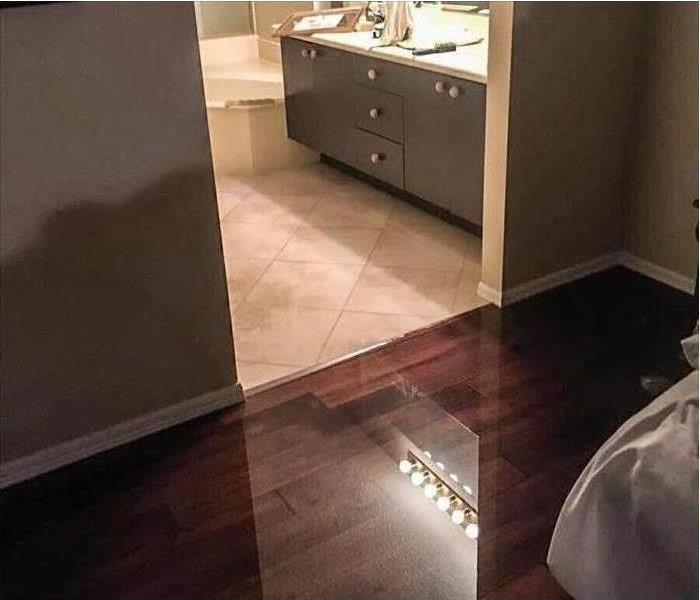 Water damage due to a clogged toilet in a Kissimmee,FL home
Water damage due to a clogged toilet in a Kissimmee,FL home
Water damage is divided into three categories for the sake of insurance and restoration purposes. Learn about the difference between Category One, Category Two, and Category Three water. More extensive sanitation procedures are necessary when dealing with contaminated water resulting from a leak or flood.
Category One Water Damage
Category One water is not actually contaminated, though it can still cause primary water damage and elevate the risk of secondary damage, such as mold growth. This type of water is:
- Clean
- Treated
- From a supply line
Category One water can degrade into Category Two or Category Three water if left standing for more than a few days. It is important to remove all standing water and completely dry the affected area to prevent damage from worsening.
Category Two Water Damage
Category Two is used to describe contaminated water that does not contain solid waste. This type of water is called gray water and may:
- Contain chemicals or microbes
- Originate from a shower
- Leak out of appliances
If a dishwasher or washing machine spills water that has been used, this leak would be considered Category Two. Cleaning and disinfection are necessary for this category of water damage.
Category 3 Water Damage
Category Three water is highly contaminated and likely to contain solid waste. This category of water is also called black water, and may originate from a sewer backup or flooding. Category Three water may also contain:
- Chemicals
- Heavy metals
- Pathogens
It is necessary to thoroughly clean and disinfect areas exposed to Category Three water. Porous building materials or contents that absorb this water must be torn out and replaced.
These are the three categories used by insurers and cleanup professionals to describe water damage. If clean or contaminated water causes damage at a residence in Kissimmee, FL, a homeowner should contact a mitigation and restoration service as soon as possible.
How to Handle Water Leaks and Floods in Your Kissimmee Home
12/6/2019 (Permalink)
 Water can easily destroy the walls, floors and structure of your house.
Water can easily destroy the walls, floors and structure of your house.
Osceola water damage can be a real problem if there is a leak or flood in your home. Water can easily destroy the walls, floors and structure of your house. It can cause dangerous mold to grow. It can ruin personal possessions and appliances. You should know what to do when faced with a water leak or flood.
Try To Stop the Leak
The first step is to try to stop the leak. Find the source of the water. If there are shutoff valves nearby, then turn them off to stop the flow of water. Alternately, you could turn off the water mains to the entire house. If neither of these steps is an option, then you might be able to seal off the source of the leak with duct tape, rags or other materials. Attempt to do this only if you can walk safely through the water.
Stop the Water from Spreading
If your home is flooding, then try to stop the water from spreading. You can use sandbags, towels or other items to create a barrier that the water cannot pass through. This will help even if you can just slow the water down a little from flowing freely into your home. You could also attempt to put down towels if the water is very shallow. This will help to limit the amount of Osceola water damage.
Get Your Possessions off The Ground
If you have possessions on the ground where the water is leaking, then pick them up. Pick up rugs, furniture and anything else. You do not want the water to destroy those items. Additionally, porous items like paper, fabrics or wood can become sources of mold after the water stops leaking. Put your items somewhere high up so that they are not in danger. Hang up any wet or soaked items to dry if possible.
Contact a Restoration Service
You should contact a restoration service like SERVPRO as soon as you realize that there is a leak and have stabilized the situation. These professionals will come into your home, remove the water and start dealing with the damage. They can dry out you floors, walls, and some personal possessions. They can also remove damaged parts of the home that are not salvageable. Restoration services are critical for recovering from water leaks or floods.
Take Preventative Action
You want to take some preventative action after the restoration company has finished. You want to inspect your plumbing regularly. Check and maintain your appliances. Have your roof checked for damage on an annual basis. Keep the number for the restoration company handy just in case. These steps will reduce the chance that you will have to deal with serious Kissimmee water damage again in the future.
Locally Owned Company with National Resources
SERVPRO of Osceola County is locally owned and operated, so we are part of this community too. When you have a flooding or water emergency, we’re already nearby and ready to help. We take pride in being a part of the Kissimmee community and want to do our part in making it the best it can be.
We proudly serve:
Water Damage Kissimmee, FL
and surrounding areas.
Understanding Secondary Water Damage
10/16/2019 (Permalink)
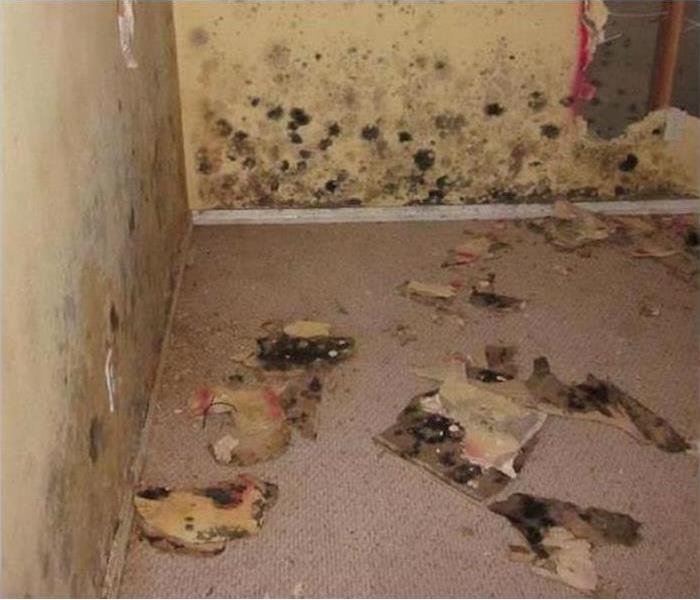 Mold damage is secondary damage
Mold damage is secondary damage
A broken pipe, a poorly placed sprinkler or a heavy storm can leave your home in a soggy situation. Water damage can range from a little dribble running down a wall to standing water to saturated walls and floors. This can be serious and may require replacing carpets, sheet rock or even studs, depending on the source and severity. High humidity remaining after the cleanup can cause secondary damage, which is just as serious.
What is Secondary Damage?
Just as standing water can cause damage, so can the black mold spores that live virtually everywhere. The spores begin to grow when exposed to the residual humidity that may remain after a leak, causing damage of the secondary type. The following things can increase the chances of mold growth, and should be checked and remedied where necessary.
A slow, ongoing leak can harbor mold growth inside cabinets, walls or other areas
Humidity levels are too high, especially in warm areas of the home
A primary water situation that is not cleaned or dried out thoroughly can invite mold growth
Not taking a water or dampness situation seriously and cleaning it properly
Is This Damage Preventable?
There is no guarantee that you can prevent the growth of black mold completely, since the spores are ubiquitous, however there are steps you an take to greatly reduce the chances. Place dehumidifiers in damp areas to reduce humidity and run fans as needed to ensure that the area has been thoroughly dried out. Make certain that the initial cause of the water has been remedied and that the water removal and cleanup was done properly. If not, call water remediation professionals in Lake Marian Highlands, FL to come and do the job effectively for you.
If, after you have experienced a flood or leak, you see any sign of the characteristic dark blotches that black mold causes, it could very well be secondary damage and should receive proper attention immediately. Ensuring that high humidity areas are effectively treated and go far in preventing more damage.
Got a Leak Under the Kitchen Sink? Take These 3 Steps Now
8/22/2019 (Permalink)
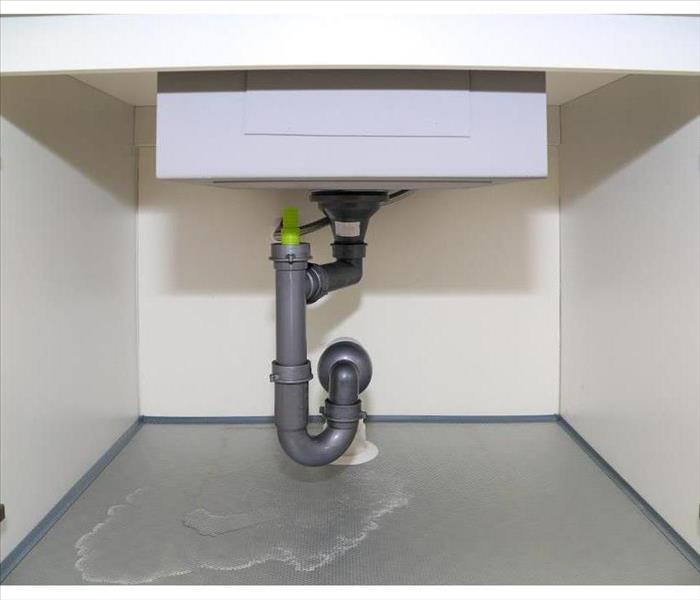 Leak under kitchen sink
Leak under kitchen sink
What To Do When You Discover a Leak Under Your Kitchen Sink
You’ve discovered a leak under your kitchen sink. Not to worry! You can prevent further flooding and damage, but you’ve got to act as quickly as possible. The steps you take now can help minimize your potential losses and start the restoration process as soon as possible.
1. Turn Off Your Water
To reduce the chances of more flooding, you need to shut off the water at its sources. Besides turning off your faucets, you may need to check the sink’s shutoff valve or supply connections. Leaks can also occur when water penetrates the countertop areas around the rim of the sink. Depending on the speed of the leak, you may need to quickly remove excess water from the cabinet bottoms under the sink to stop sitting water from damaging the wood. You should also move vulnerable items to safe, dry places within your home.
2. Contact Your Insurer
Extensive leaks that leave a lot of water in your home could result in significant water damage claims. If this is the case, you need to contact your insurance company as soon as possible. Concentrate on documenting anything that shows the extent of your loss: photos of the impacted areas, written descriptions of the damage and an inventory of affected items.
3. Call a Trusted Restoration Company
Time is of the essence when you’re dealing with a serious kitchen plumbing leak in Celebration, FL. The sooner you contact a reputable water damage restoration company, the more quickly your kitchen repair and recovery process can begin. Look for responsive professionals who are available 24/7 and are Faster to any size disaster.
A Few Last Words
When you’re dealing with flooding, you must keep your family’s safety in mind, as well as your own. Avoid attempting to vacuum up the water yourself, don’t use electrical appliances in the affected areas and don’t leave wet fabrics or printed items on the floor. Following these tips and acting quickly can improve potential outcomes after a serious leak.
What Water Pipe Noises Might Mean: 3 Reasons Revealed
10/5/2018 (Permalink)
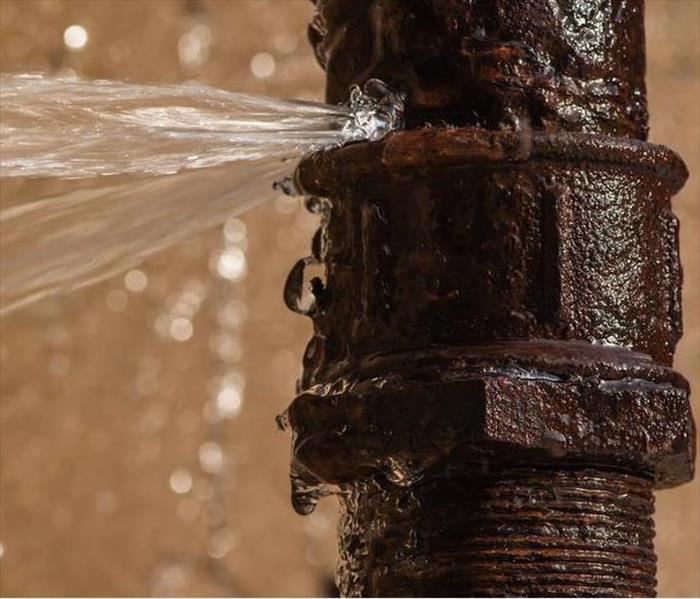 A broken pipe can make you end up with a flooded home in Holopaw,FL
A broken pipe can make you end up with a flooded home in Holopaw,FL
If the water pipes in your Holopaw, FL, home make a variety of noises, you might think it is normal for them to do so. However, certain sounds may be indicative of a big problem or impending malfunction, such as a pipe break. Listening to these sounds and learning what they mean can help you find their source and resolve the issue before you end up with a flooded home and a hefty repair bill.
1. Squealing
If your pipes squeal when you turn the water on, this may mean that there is a blockage or that a washer or screw is not positioned correctly. A blockage can be a more serious issue, as a pipe break could occur if it is not removed. If you notice the squealing gets worse over time, you may want to call in a plumber to locate where the blockage is before it causes damage.
2. Banging
Water pipe banging can be alarming because it may sound like a pipe burst is about to occur. However, this is not a serious plumbing problem and is quite common. When water is shut off quickly, the valve closes all at once and the remaining water in the pipes moves rapidly, causing them to vibrate against the wall. You can wrap the shaking pipes with insulation or place flexible padding behind them to reduce noise. If you notice any cracks or bulging, you may want to contact a water damage and remediation service to fix a broken pipe before it can cause a flood.
3. Toilet Whistling
If your toilet whistles upon filling, this is usually more of a tank issue than a pipe valve problem. If the sound stops once the tank is filled, check the ballcock unit and adjust or replace it as needed.
When water pipes make noise at your Holopaw, FL, home, it can be startling. However, knowing what the noises mean and whether a pipe break is imminent can help you prevent costly floods before they happen.
Fire Sprinkler Maintenance: Here Is What You Need To Know
9/25/2018 (Permalink)
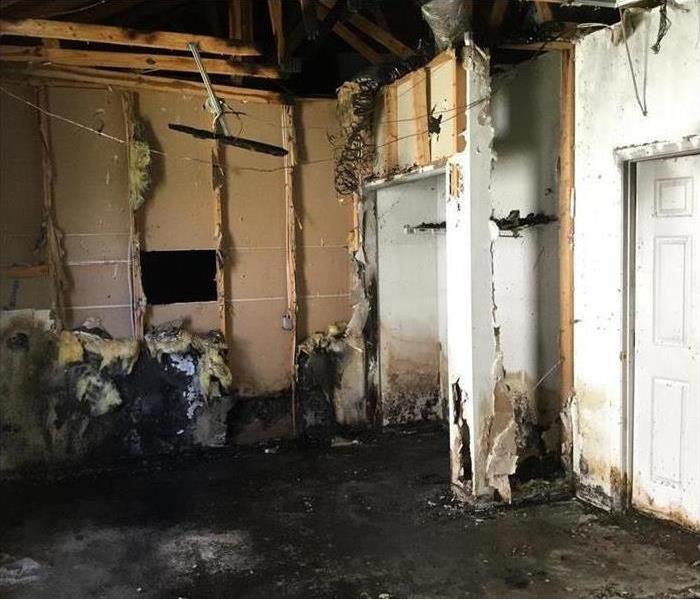 Fire and water damage in Saint Cloud, FL
Fire and water damage in Saint Cloud, FL
Fire sprinklers are an essential part of any building's safety system, and sprinkler maintenance an essential business function. In fact, reports shared by the National Fire Protection Agency reveal that working sprinklers not only prevent costly damage but also prevent injury and even death. Below are just a few of the most astonishing findings:
- When sprinkler systems are present during a fire, the firefighter injury rate is, on average, 80 percent lower.
- When both sprinklers and fire alarms are present, the death rate drops by approximately 90 percent.
- When working sprinklers are present, fires are restrained to the room of origin 97 percent of the time.
These stats indicate that sprinklers are not only necessary, but that sprinkler maintenance should be a key function of any business.
How To Maintain Your Sprinkler System
Fire sprinklers should be inspected on a weekly, monthly, quarterly and annual basis. During your weekly inspection, you should check the gauges for a read on normal air and water pressure. You should also check the control valves to make sure that they work properly and that they're locked, sealed and ready to open when necessary.
During your monthly inspections, re-inspect your gauges and check your alarm valves. During the quarterly checks, examine the alarm devices and the hydraulic nameplate to ensure that it is secured to the sprinkler riser.
As a business owner, you are required to have a licensed technician inspect your sprinkler system on an annual basis. During this yearly inspection, your technician assesses and maintains all aspects of your system, including the following:
- Alarm devices
- Gauges
- Pipes and fittings
- Control valves
- Sprinkler heads
- Deluge valves
- Hangers/bracing
- Antifreeze solution
- Backflow prevention components
- Water flow alarm
- Main drain
If the technician notices any issues or obstructions, he or she will perform the necessary repairs.
Sprinkler maintenance is a key business operation. Your attention to your sprinkler system can prevent costly and even potentially fatal damage. For more information on what you can do to maintain a safe work environment, contact your Saint Cloud, FL, fire remediation team.
Leaky Faucet Tips and repair
8/17/2018 (Permalink)
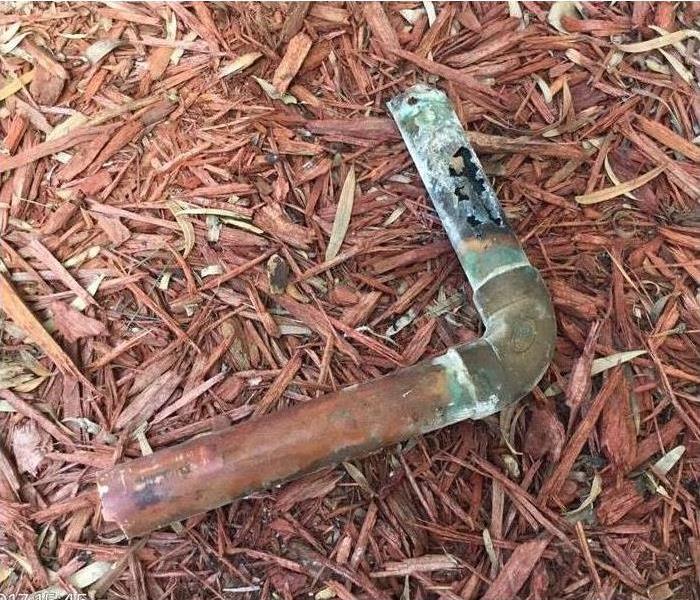 Water damage at a Kissimmee, Florida residence
Water damage at a Kissimmee, Florida residence
While a leaky faucet might seem like a small nuisance, leaving it unfixed can lead to a number of unwanted consequences. Some of the more serious reasons you should take care of this issue are because a leaking faucet can
- Waste hundreds of gallons of water each year
- Increase the cost of your water bill
- Cause structural damage as severe wood damage or mold.
The DIY Guide to Fixing Your Leaking Faucet
Are you ready to take on the task yourself? Fixing a dripping faucet isn’t usually too complicated of a job. Follow our easy instructions and you should get your tap dry in no time.
1. Prepare Your Sink for Fixing
Before you fiddle with your faucet, look under your sink for a handle along the pipes leading up to the tap. Turn it clockwise to stop the water. Then plug your drain before you take apart your faucet, so you don’t lose any small screws or washers.
2. Determine Your Faucet Type
There are four different commonly found faucet types. A tap with separate temperature handles is called a compression faucet, while a tap with one handle can either be a ceramic-disk faucet (contains a ceramic cylinder), a ball faucet (contains a ball bearing), or a cartridge faucet (contains a cartridge).
3. Find Your Replacement Parts
Take your tap apart to check for broken parts (such as the rubber washers on compression faucets) and give it a deep cleaning by soaking it in white vinegar. Take the stem and inner parts to a hardware store to find an exact replacement. Reassemble your new faucet and you should be good to go.
Assessing the Damage
If you’ve had a leaking faucet for a while, it’s good to get your sink area assessed for further damage. Find a restoration specialist in Kissimmee, FL to check that your house is mold free and not at risk for any structural damage. They can also make sure that your fixed leak isn’t going to come back anytime soon — a comfort to any homeowner.
#easybrokenpipe
6 Misconception About Water Damage
12/29/2016 (Permalink)
You may think water damage is quite straight forward. However, there are actually quite a few misconceptions about water damage. Here are some common misconceptions to avoid.
It will dry itself
When water leaks into your home and gets onto your floors and walls, there is no doubt that mold will grow if it is not removed properly. The area may appear to be dry, but water can hide in the walls and underneath your flooring, which increases your risk of mold growth. That mold can be extremely expensive to remove the more it spreads and the area will create a musky odor. Water damaged areas begin to stink if they are not completely dried out and treated with the proper antimicrobials. The water will not actually dry on it’s own, but it will seep into other areas and cause damage the more it is able to travel.
It is not a big deal
The mold and bacteria that begin to grow in standing water can cause diseases and infections if left untreated for even just one day. Proper sanitation, disinfection, and anti-fungicide treatments must be applied immediately to ensure that the health of everyone in the area is not compromised. SERVPRO has the equipment and products that guarantee the area is cleaned thoroughly and properly. Do not brush the situation off and think that standing water in your property is no big deal, it has the possibility of becoming a tremendous health hazard if not addressed immediately.
I can dry it myself
This may be many people’s first instinct, but we heavily advise against trying to clean up a large amount of water on your own. This can lead to serious mold growth and eventually cause your flooring or walls to be completely ruined. SERVPRO has the state of the art equipment and skilled technicians necessary to expedite the drying process and save the walls and flooring in your home.
I can’t see it so it’s not there
The tricky part about dealing with water damage is that once water starts to leak, it can hide in your walls, floors, or ceiling after any flood or spill. The SERVPRO advanced technology actually gives us the ability to detect moisture throughout your home so that it is guaranteed that no water can hide and cause further damage. Whether it is water on the floor, or on your belongings, our trained experts are able to detect the moisture and eliminate it quickly so that your home can return to normal.
The cleanup is expensive
The cost of hiring professionals to take care of any water damage is usually the reason people avoid it and attempt the cleanup on their own. The idea that hiring SERVPRO for an inspection and cleaning is going to cost an arm and a leg is actually a myth. The powerful equipment used by our cleaning and restoration specialists are able to both clean and remove contaminants, which saves anyone from having to replace all of their belongings. A few hundred dollars of cleanup and restoration can turn into thousands of dollars of replacement, especially if any of the process is put on hold or delayed. The reality is, you actually save money by bringing SERVPRO in to handle the cleanup and restoration because it will be done correctly the first time.
It is a good idea to check with your insurance company on what they cover as far as water damage goes. It may be that insurance will cover the damage and the whole process will actually result in no money out of your pocket. If that is the case, it will cost nothing to have all of your property and belongings cleaned and restored.
It can wait
Water is the base of all living things and it does not take very long for life to begin to grow in standing water. Mold starts to grow within 24 hours of water left standing and spreads quickly. Take initiative right away so that the situation does not become worse. It is much cheaper to clean up the water and repair the damage than it is to replace entire walls, floors, and furniture. Call SERVPRO of South Brevard immediately and one of our highly trained technicians will respond to your need right away. We have a 24-Hour Emergency Service and are locally owned and operated. You need the company that can respond immediately and has the expertise and equipment to properly restore your property.
Tips to Avoid Water Damage
12/16/2016 (Permalink)
Water damage is a serious risk for buildings. If not addressed immediately, it can create irreparable damage to your personal possessions, the structural stability to the building, and can cause health hazards for occupants. However, there are steps that you can take to help avoid such a situation.
Identifying Potential Hazards
The first step to avoiding water damage is to identify the potential hazards where water damage can occur. Most notably, if you have any leaks or cracks that can allow water in, they should be fixed as soon as possible.
Windows and Doors
As usual openings into the building, windows and doors are common sources of water damage. Regularly checking your windows and doors for leaks will help ensure that they don’t cause water damage problems. If there are leaks, it may be an issue with the sealing around the opening.
Roof
Oftentimes, water damage initially comes from the roof. When leaks or roof damage allow water to infiltrate the building, that water will slowly make its way through the home damaging the attic, walls, and eventually the floors. Primary issues that result in water damage from the roof are leaks around vents for the exhaust for plumbing, rooftop air conditioning units, and other types of specialized equipment. Another common problem is with the roof’s drainage system, particularly the gutters. Making sure your gutters are in good condition and draining water properly will ensure it doesn’t cause water damage to the building or its foundation.
Foundation and Exterior Walls
Water can do the most damage to the foundation and exterior walls. Water damage to these parts of the building can compromise its structural integrity and cause openings such as doors and windows to stick. To avoid any danger of damage occurring to these areas, seal any cracks or hold that may have accumulated in the exterior walls, joints, and foundation. You also need to make sure that your yard slopes down away from the foundation and that the roof drainage system directs water well away from the building.
Plumbing
Inside the building, most water damage problems occur from areas where water use is common. Make sure that there are no leaks in the plumbing fixtures, that the pipes are not dripping, that the drains are not clogged, and that any water drainage systems are not defective.
Heating, Ventilation, and Air Condition (HVAC)
HVAC systems are made up of various components that can cause the accumulation of moisture in a building. Some of these components include chilled water piping and condensation drains. If the building is in a humid climate, a HVAC system serves the purpose of reducing the ambient air moisture level. If the system is not working properly, it will not do this which could result in water damage.
Inspect and Maintain
A key to keeping water damage from negatively affecting your home is to decrease the chances that water damage can occur. The best way to do this is to regularly inspect and maintain any parts of your home that could potentially be vulnerable to water damage or water intrusion.
Flashing and Sealants
The purpose of flashing is to prevent water from entering the home where two different types of building materials come together. Flashing is usually a thin metal strip and can be found around doors, windows, and roofs. Similarly, sealants and caulking are typically applied to prevent any moisture intrusion at the building’s joints. To keep water from slipping past these parts of the building, they must be well-maintained and in good condition.
Vents
If your vents are not properly maintained, they can be hazards for water damage. To avoid such a problem, all vents in the building should have the appropriate hoods, exhaust to the exterior, and should be in good working order.
HVAC
Many HVAC systems are made up of several components that could potentially cause water damage if regular maintenance is ignored. Check all these components such as water lines, pumps, and air handlers for leaks. You should also make sure that the drain lines are clean and don’t have any obstructions and that the ductwork is insulated so it prevents condensation on exterior surfaces.
Humidity
The relative humidity of a building should typically be 30 percent to 50 percent. If the humidity is too high, it will likely show through condensation on the windows, wet stains on the walls and ceilings, or musty smells.
Moist Areas
If there are any areas of the building that commonly become moist for any reason, these areas should be cleaned off and the area where the moisture frequently collects should be dried.
If not taken care of immediately, water damage can have very negative effects on a building. It can cause severe damage to personal possessions, cause damage to walls and floors, and make the building uninhabitable by putting into question its structural integrity. These tips will help you avoid having to deal with such a situation. If you do suffer any type of water damage to your home, call the professionals at SERVPRO for a full restoration.
4 Ways to Protect Your Foundation
11/30/2016 (Permalink)
A sturdy foundation is integral to the stability of your home. Issues with the foundation can cause structural issues with the home which will result in thousands of dollars of damage and can create issues that would require further repair. There are measures you can take to protect your home from such a problem and to check to make sure that the foundation of your home is properly protected.
Grading to Keep Water Away from the Foundation
If the excavation of soil is done poorly around a house, the water could potentially be directed toward the base of that house and could funnel into the foundation. To avoid this problem, the yard should be graded at least six inches in 10 feet, which will ensure that the soil slopes away from the house. To make sure that the slope is enough to avoid such an issue, you can simply use a leveling tool. With one end of the level where the ground meets the foundation wall and the other end sticking out, measure the space from the end hovering over the ground to the surface of the ground. This will tell you the slope. If you are using a two-foot level, simply multiple the results by five to find what it would be at 10 feet.
Direct Water Away from the Foundation
Any downspouts of the house should be directing water away from the house and its foundation. This will ensure that any rainwater or roof runoff is flowing away from the house and not down into the foundation. To avoid the water flowing down into the foundation, the downspout should extend five to 10 feet away from the house, otherwise it will simply be dumping water onto the foundation which can cause extensive damage. While simply purchasing extenders is a way to handle this situation, there is another way. You can bury a long diverter underground which will drain the water all the way to the curb, to a storm drain, or to a spot that is further out in the yard where the water will be of no danger to the foundation.
Avoid Dry Soil
When soil around the house completely dries out, it has the ability to contract, then expand when it gets wet again. It’s important to avoid letting any soil that is around the home become completely dry during any long dry spells as the next time it rains, the soil could become soaked causing it to expand and put stress on the foundation walls. You can avoid this problem by running a soaker hose around the house about six inches away from the foundation and three inches underneath the soil any time there is a drought. This will keep the soil from contracting and expanding, keeping your foundation safe.
Protect Your Foundation from Roots
During a drought, there is only so much moisture to go around, so tree and shrub roots are forced to share moisture with the soil. Lacking enough moisture to go around, this issue can cause the foundation to settle and sink unevenly. The result of this is that drywall can crack and windows and doors may stick to their frames. The way to avoid this problem is by planting any deep-rooted trees and shrubs away from the home. If the branches of the trees or shrubs are touching the house, they are too close and can potentially cause a problem.
Damage to a home’s foundation is a serious problem. In addition to causing structural issues for the house, it also has the ability to cause problems to drywall, windows, doors, and floors. The result of the foundation issues could be thousands of dollars of damage to correct multiple problems throughout the house. But water damage can be corrected with little to no permanent damage if it is caught fast enough and if the appropriate steps are taken to correct the situation. The difference between a quick notification and waiting could be devastating. If you suffer water damage to your home, it is important that you contact that professionals at SERVPRO right away to ensure that the matter is properly handled to avoid any further damage and to correct the situation right away.
4 Signs Your Gutters May Cause Water Damage
10/18/2016 (Permalink)
Every homeowner fears the threat of water damage. Many of these threats come from situations such as leaks in the roof or some other way that water passes into the home. One of the most common and noticeable appliances that are designed to keep water from entering the home are the gutters. The purpose of the gutters is to carry rainwater down and away from the home. This allows the home to avoid any potential water-related problems, such as flooding, leaks, or damage to the foundation. If your gutters are not working properly, the result could be very serious water damage occurring to your home. These four signs will tell you that your gutters are not working properly and are in need of repair or, possibly, replacement.
Gutters are Sagging Away from the House
If your gutters are noticeably sagging, they will not be properly doing their job of leading the water down and away from the house. This is one of the easiest ways to tell that you may have an issue because you can tell it’s happening simply by looking up. The reason why your gutters may be sagging is that they are full of heavy water. This can cause the gutters to not drain properly which could result in other issues such as cracks or holes forming in the gutters. If this happens, water may start spilling down the side of the house causing water damage in the home or to the foundation.
Gutters are Starting to Show Rust
Noticing that your gutters are starting to rust is not as easy as noticing that the gutters are sagging. For this problem, you’ll have to climb up onto the roof or climb up a ladder to notice it. However, if you are able to get some elevation above the gutters, the rusting will be quite noticeable. To ensure that your gutters are working properly, you should regularly inspect them. Any rust should be easily noticed during this inspection.
Over time, if the gutters are not attended to, holes or cracks may form which could cause water to spill out of the gutters, run down the side of the house, and damage the foundation of the home. If your gutters are rusted and are in need of a replacement, you might want to consider getting aluminum gutters. These gutters don’t rust which will ensure that your problem doesn’t happen again.
Marks Are Showing Up On the Exterior of the Home
Cracks or holes in your gutters will cause water to stream down the side of your home. This will leave water stains, cause paint to peel, and mold to grow. Signs of these problems will show up on the exterior walls of the home or right underneath the gutters. This is a sign that your gutters are not directing water down and away from the house but that water is escaping the gutters. As the water continues down toward the ground, it can eventually cause water damage to your home and damage to the foundation of the home.
Splits and/or Cracks Are Forming in the Gutters
Tiny splits or cracks that form in the gutters may not seem like a big deal as water is not even escaping at that point. But the force of the running water can cause these small cracks to become big cracks rather quickly. Water will then easily escape the gutters and stream down the side of the house where it can cause damage to the house and its foundation. Sometimes you can repair these cracks using specialized tape or roofing cement but you may have to completely replace the gutters if the cracks are too big or if there are too many of them.
If there are problems with your gutters that are causing them to stop directing water down and away from your home, issues involving water damage can arise. In some cases, you may be able to repair the gutters but in many cases, you will have to completely replace them. Either way, it’s important that you keep a close eye on your gutters through regular inspection as this will allow you to avoid potential water damage. If you do suffer from water damage, call on the professionals at SERVPRO for a full restoration.
What Goes Into a Water Damage Assessment
10/5/2016 (Permalink)
Water damage is one of the most devastating events that can happen to a homeowner. Not only does it have the ability to immediately cause substantial damage to your property and possessions, but the situation can get worse over time if the water damage is not properly treated. The first step to planning the appropriate restoration is to complete a full assessment of the water damage. This water damage assessment will let those working on restoring the property know exactly what needs to be done to restore the building as well as allow them to determine what can be saved and what must go.
If water damage occurs in your home, it’s important that only professionals handle the cleanup. Cleaning up water damage can be a complex task and attempting to clean up the damage yourself may only make matters worse. Plus, the longer you wait to get professionals involved, the worse the damage will be. While you should get out of the way and allow the professionals to clean up, this is the assessment they will perform upon arriving.
Structural Assessment
The main type of water damage assessment that the crews from SERVPRO will accomplish is a structural assessment. Assessing the structural issues of the home that have been caused by water damage will allow them to decide on the necessary course of action. These are the aspects of the structure that will be assessed during this process.
Roof
The roof acts as a building’s main line of defense against the elements of nature. Issues with the roof that allow water to seep in and collect in the attic and crawl down the wall can create additional problems such as mold. During the structural assessment process, inspectors will look for any areas of the roof that may be vulnerable to collapse, any missing or damaged shingles, any bent or damaged gutters, any crack or damaged chimneys, and any stains or cracks on exterior surfaces.
Exterior Walls and Windows
Water has the ability to move into places and cause damage that you probably wouldn’t expect. Based on how the damage occurred, there can be several types of damage to walls, windows, and the exterior walls of your home. When water collects behind walls and other areas around the house, they can put the stability of the structure into question without the occupants noticing. When the inspection is being completed following water damage, the inspectors will look for any collapsed walls, broken or cracked windows, wet bricks or exterior walls, and any signs of water coming through windows.
Front and Back Yard
While the inspection of water damage will be primarily focused on the building, there are other parts of your property that may be of interest. As you might expect, a large accumulation of water can collect in your yard and in garden-type areas. Flooding in your yard not only will ruin your landscaping, but can also cause damage to the foundation of your home. As you would probably guess, flooding in garden areas of your home can kill your plants and flowers.
Attic
Damage that might occur to your roof such as missing or damaged shingles or holes can allow water to make its way down into your attic. While water damage in your attic is bad enough considering many attics are used as home storage units, the water can seep into your walls from creating unseen damage that could result in health risks such as mold. When your home is being inspected, your attic will be examined to see if there has been any damage that needs to be treated. Signs of water damage in the attic include a wet or cracked ceiling, walls, or floors, wet insulations, and wet or damaged vents and ducts.
Rooms
One of the first places that will be examined when your home is inspected for water damage are the rooms themselves. The inspection will include looking for any wet spots in the ceilings, walls, or floors, sunk electric and phone jacks, warped or damaged wood, and cracked or broken windows and doors.
Bathrooms
Given how much water goes through your bathroom, this room is often a cause of water damage. Even though these rooms are built with consideration of how much water will go through it, issues with your plumbing can cause significant water damage if not addressed immediately. Signs that your bathroom may have water damage include damaged bathtub, stains on sinks or countertops, and leaky or slumping ground around your toilet tank.
If you have water damage in your home, every minute counts. As more time goes by with the proper treatment, the damage worsens and becomes more permanent. When the professionals at SERVPRO respond to your call, they will start with a water damage assessment to get a better understanding of the extent of the damage and see what can be salvaged and what must be discarded.
Preventing Water Damage in Vulnerables Parts of Home
9/26/2016 (Permalink)
Water damage is a problem that all homeowners fear. Whether it is from a gentle rain or a torrential downpour, the littlest of water damage can put a significant dent in your bank account. Water has several ways of entering your home. Be it from insufficient insulation in the roof or some other entrance around the home, water can easily sneak in and collect. Sometimes it can get into the home without the occupants noticing. The next thing you know, it’s too late and you have thousands of dollars worth of damage to your home.
The damage to your home is not just financial either. Water damage worsens very quickly and causes other problems that can affect other aspects of your life. If in the proper environment, as water damage typically is, mold has the ability to grow. Sometimes this mold grows inside walls where it cannot be seen by the occupants. This can cause health issues for occupants of the home which include respiratory problems, allergies, among other illnesses.
While water damage can be very hard to notice until it is too late, especially by someone that does not know the tell-tale signs, there are steps that you can take to avoid water damage, or at least limit the amount of water damage. Here are some tips to help you avoid potential water damage in your home.
Wrapping Potential Water Entrances
There are several potential entrances for water around your home. Be it from the roof, window, door, or some other spot of the house, these entrances could make your home vulnerable to water damage during the next storm. A way to avoid such problems is housewrap. You may have noticed housewrap covering houses during construction. The reason for the invention of housewrap was to keep water out of the crevices of the home. Typically, housewrap does exactly as its name implies, it wraps all the way around the home, keeping it safe from potential water intrusion. The areas you would expect to be vulnerable to water intrusion, windows, utility penetrations, and intersecting roofs should be given special consideration.
Seal Your Windows
As parts of the house that are designed to open, windows are particularly vulnerable to allowing water into the home. Obviously, windows can’t be completely sealed like many parts of the house because they need to be able to open. That is, if they want to be used the way they were designed. But, by ensuring that your windows have the proper flashing and sealants layered on the window, you shouldn’t have a problem keeping water out of the house.
Utility Exposures
Houses often have areas that can be exposed to the outside elements due to utilities. This could include a hose bib, dryer vent, or some other fixture that allows the house to be exposed to outside elements. It is situations like this where flashing has its biggest impact on your home. Just like with windows and doors, flashing will ensure that these utility necessities keep the house protected from any potential water damage while still allowing the utility what is needed to serve its purpose.
Where the Wall Meets the Roof
The most vulnerable areas of a house to water damage is where two different materials meet. When the home is being built, contractors put protections in place to ensure that these parts of the house are protected from potential water damage. But, over time, the elements can wear down those protections so it is a good idea to keep a sharp eye on those parts of the house. As rain water hits the roof and slides down the house, no part of the house is more vulnerable to water damage as where the wall meets the roof. Making things even more potentially troublesome is that if water were to get into a crease in that part of the house, the water could travel down the wall and create significant damage before the occupants of the house were even aware of the initial damage.
No matter how you attempt to protect it, certain parts of your home are going to be vulnerable to water damage. Even though the amount of water might be small, depending on where the water ends up, the damage could be extensive in the price to restore. These tips will help should you find yourself in such a situation. If you have water damage and are in need of restoration, call the professionals at SERVPRO.
Dealing with Water Damage
9/1/2016 (Permalink)
Water damage is one of the most distressing situations for a homeowner. It has the ability to cause extensive damage to the home and requires a costly cleanup. If water damage occurs in your home, it’s important to have the situation remedied quickly by professionals to avoid further problems.
How Water Damage Occurs
There are several different ways in which water can enter the home. These include leaks in the foundation, pipes that have burst, appliance valve failures, and poor drainage around the home. A burst pipe, valve failures, and sewage backups are the most substantially damaging events as they create the possibility of several inches of water accumulation in just a matter of hours. A burst pipe and valve failures are less harmful but create extensive damage. A sewage backup produces harmful water that can cause serious illness to any who ingests it.
Potential Dangers of Water Damage
There are many potential dangers associated with water damage in the home. When water collects throughout the home, it has the ability to soak through anything that it comes into contact with rather quickly. If the collected water has been contaminated, it creates further problems. Contaminated water is the environment in which a variety of microbes, that can include dangerous viruses and bacteria, live and grow. So any organic materials, such as textiles or wood, that have been damaged by contaminated water must be restored for the safety of the home’s occupants.
Another major concern when water collects in a home is mold. The ideal environment for mold growth is damp and warm, which is why the growth of mold is such a danger following water damage in the home. If the mold growth is not soon treated, the spores have the ability to spread through the air which allows it to spread quickly and to areas that seem dry. While being exposed to mold in the short term is not necessary dangerous, the consistent inhalation of the spores over a longer period of time can cause various health issues such as respiratory infections, nausea, agitation, malaise, fatigue, and neurotoxic problems. These medical issues are especially a danger for children, the elderly, and those with a weakened immune system.
Water Damage Should Be Addressed Immediately
Water damage in the home is not something that should be put off, but should be addressed immediately. The more time you wait to start the restoration process, the more problems and more expense will occur.
Within just minutes of the water damage occurring, the water will begin to spread throughout the house, saturating everything it comes into contact with. This can cause the finishing on furniture to bleed, which can cause permanent staining on carpets. Photographs, books, and other paper products may start to swell and warp.
Within the first day, damage to permanent fixtures around the house will occur. Drywall may begin to well and break down, metal objects may begin to tarnish, furniture may begin to swell or crack, and dyes and inks from cloth or paper goods around the house may start to spread and stain. At this point, you may also begin to notice a musty odor around the water damaged house.
From two days to a week, the damage will increasingly get worse and start to damage more parts of the house. At this point, mold and mildew may begin to grow and spread which could start creating health issues. Doors, windows, and studs in the wall may begin to well up and warp creating structural issues in the house. Paint in the house will begin to blister, wood flooring may swell and warp, and the possibility of serious biohazard contamination may occur.
If you wait more than a week, the damage will be catastrophic. The time and cost of the restoration will have already increased significantly as the replacement of contaminated materials and structural rebuilding may be quite extensive.
Water damage in a house can be a difficult experience for a homeowner. It has the ability to cause property damage and can cause health issues for occupants of the home. If you have water, fire, or mold damage in your home, call on the professionals at SERVPRO to fully restore your home.
How to Handle Water Damage to Floors
8/15/2016 (Permalink)
One of the biggest fears of homeowners is the threat of water damage. If not quickly addressed, water damage has the potential to worsen and create bigger problems that negatively affects the health and well-being of the building’s occupants. Mold, for example, thrives in an environment like a water damaged building and has the ability to create problems throughout the building. It can also cause structural damage to the building over time. Understanding how to identify whether or not you have water damage and knowing what to do when you do identify water damage is key to quickly getting the issue resolved which will allow you to limit the damage.
Causes of Water Damage
There are many parts of a building that are susceptible to water damage like the ceiling and walls. Another area that’s susceptible to water damage is flooring. There are many different reasons that you may have water damage to your flooring. A pipe that is leaking, a roof that is leaking, or a drink that has spilled are all potential causes of water damaged flooring. Flash flooding is likely to cause more water damage to the floor than anything else. Finding out the cause of the water damage is key to knowing how much water damage exists. It will tell you where to look for the water damage and how extensive the cleanup will be.
Signs of a Water Damaged Floor
If you think that you may have water damage to your floor, you need to be aware of the signs that there is water damage to your flooring. If you have suffered a roof leak, a leaking pipe, or something else that could potentially cause water damage, you’ll need to be on the lookout for the signs that there’s water damage to your floor. These signs include a discoloration of the carpet, a sagging spot in the floor, or rotten wood the sinks beneath the shoes. If wood is rotting, it will sag down more than a hard wood floor. It also won’t echo as well if you knock on it. If any of these signs are apparent on your floors, you’ll know that you must take action to prevent any further damage from occurring.
Finding the Water Damage
Noticing the signs of a water damaged floor is the first step, but more needs to be done to find out exactly where the water damage is and the extent of the damage. One way you can find out more about the damage is to pull up the carpet. Pulling up the carpet will show definite signs if there is water damage. If you don’t want to pull up any of the carpet, you can look underneath the crawl space. However, if there is water damage to the flooring underneath the carpet, it will eventually have to be pulled up regardless. If the carpet is discolored or has signs of mildew, it will need to be replaced.
Professionals Should Be Brought in to Restore
Just like with any other type of water damage, if there is water damage to the floors, professionals should be called in to handle the job. Professionals know the necessary steps, safety procedures, and have the training to ensure that the area is properly and safely cleaned up. If you’re inexperienced in cleaning up water damage, attempting to take on the task yourself could result in mistakes that could further damage the building or create health hazards for the occupants of the building. Hiring professionals to handle the job will ensure that the building will be fully restored and that no additional damage will be caused. When they’re finished, you’ll be able to reoccupy the building without fear that there’s any damage or health hazards in the building due to the water damaged floors.
Water damage is a worry for all homeowners. In addition to ceilings and walls, floors are also a part of the house that’s susceptible to water damage. Anything from a roof leak to a leaking pipe or spilled drink could potentially result in water damage to the floor. If you do suffer water damage to your floors, or any other part of your house, call on the professionals at SERVPRO to ensure a proper and safe restoration.

 24/7 Emergency Service
24/7 Emergency Service



